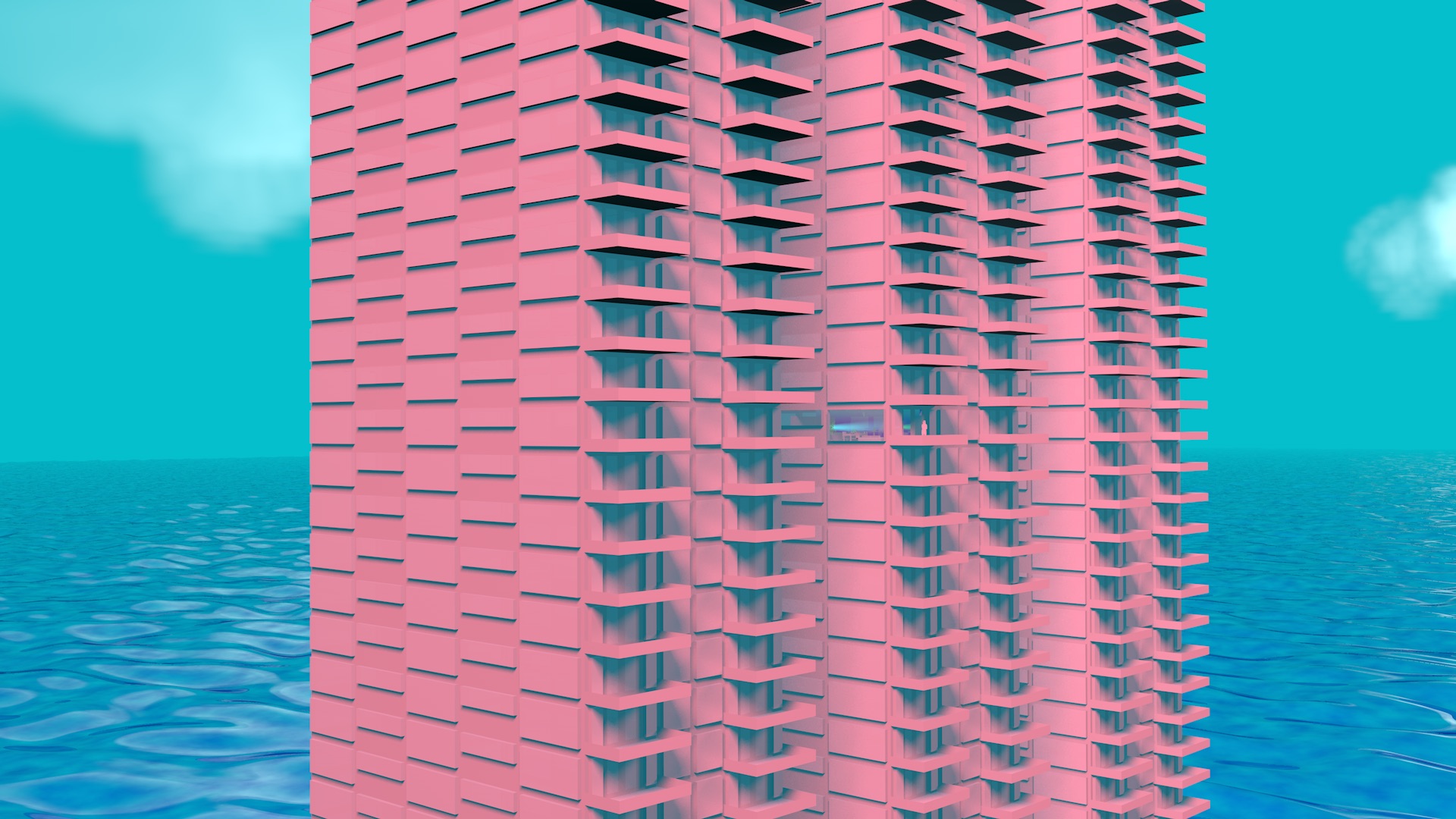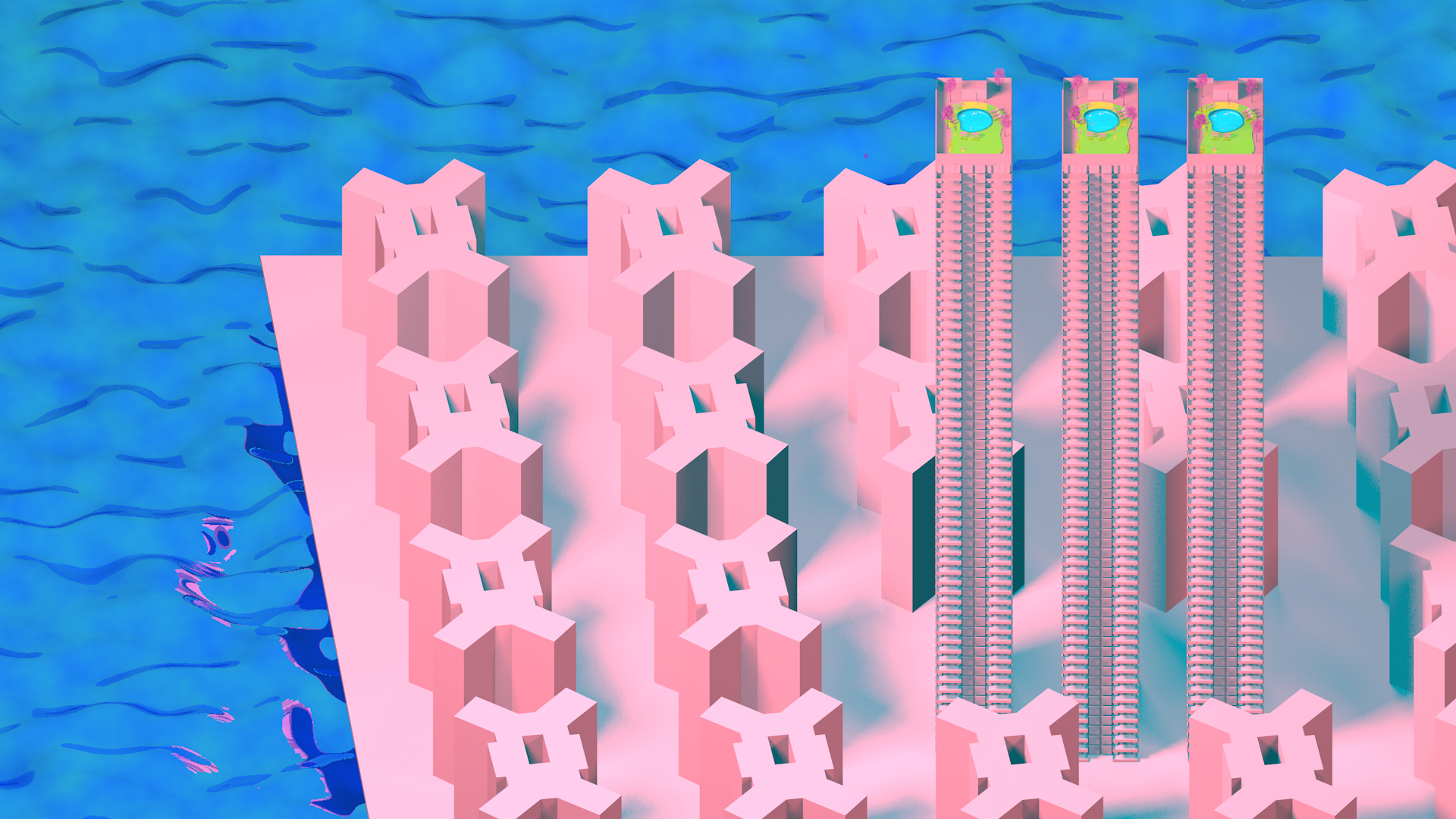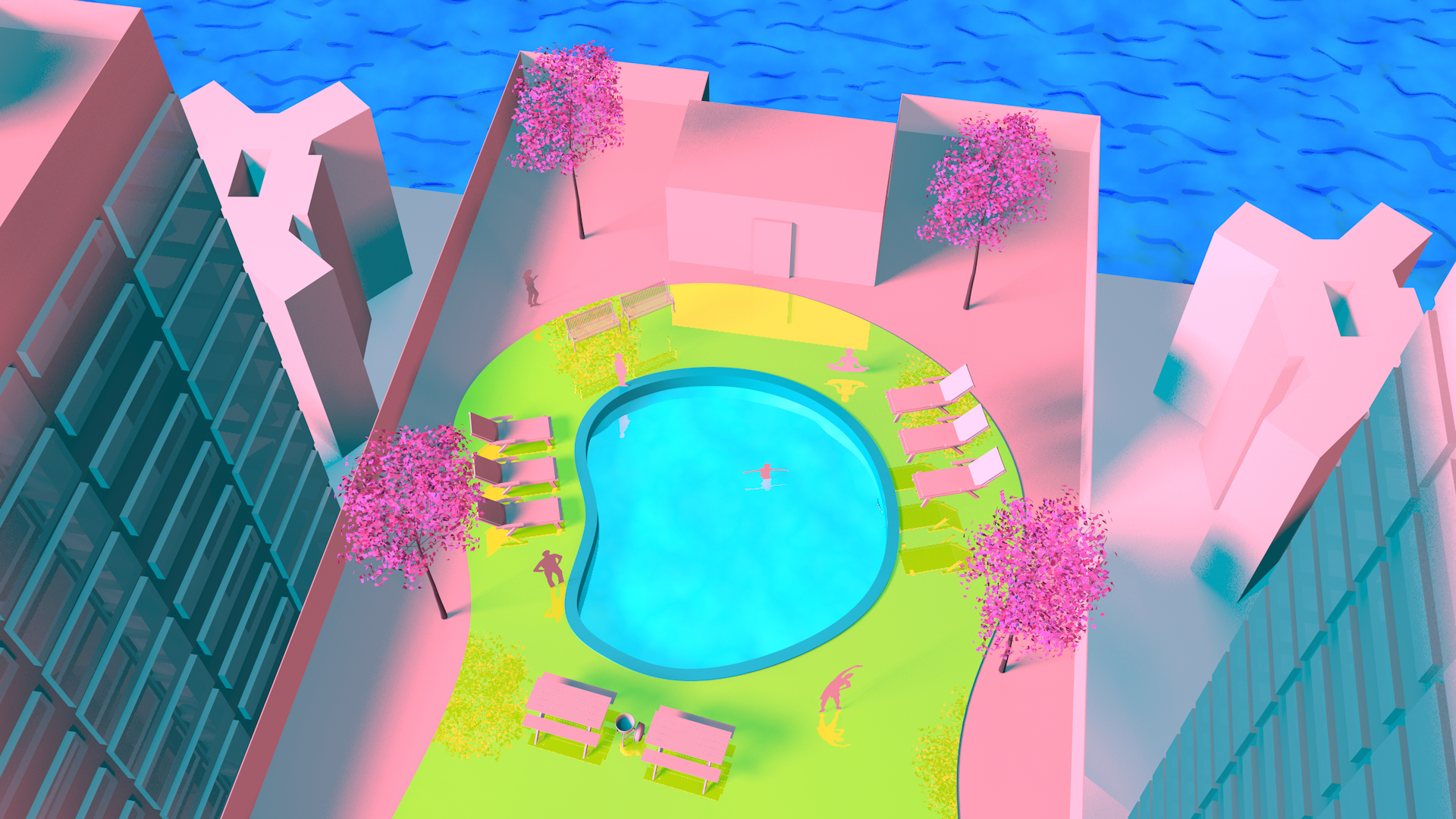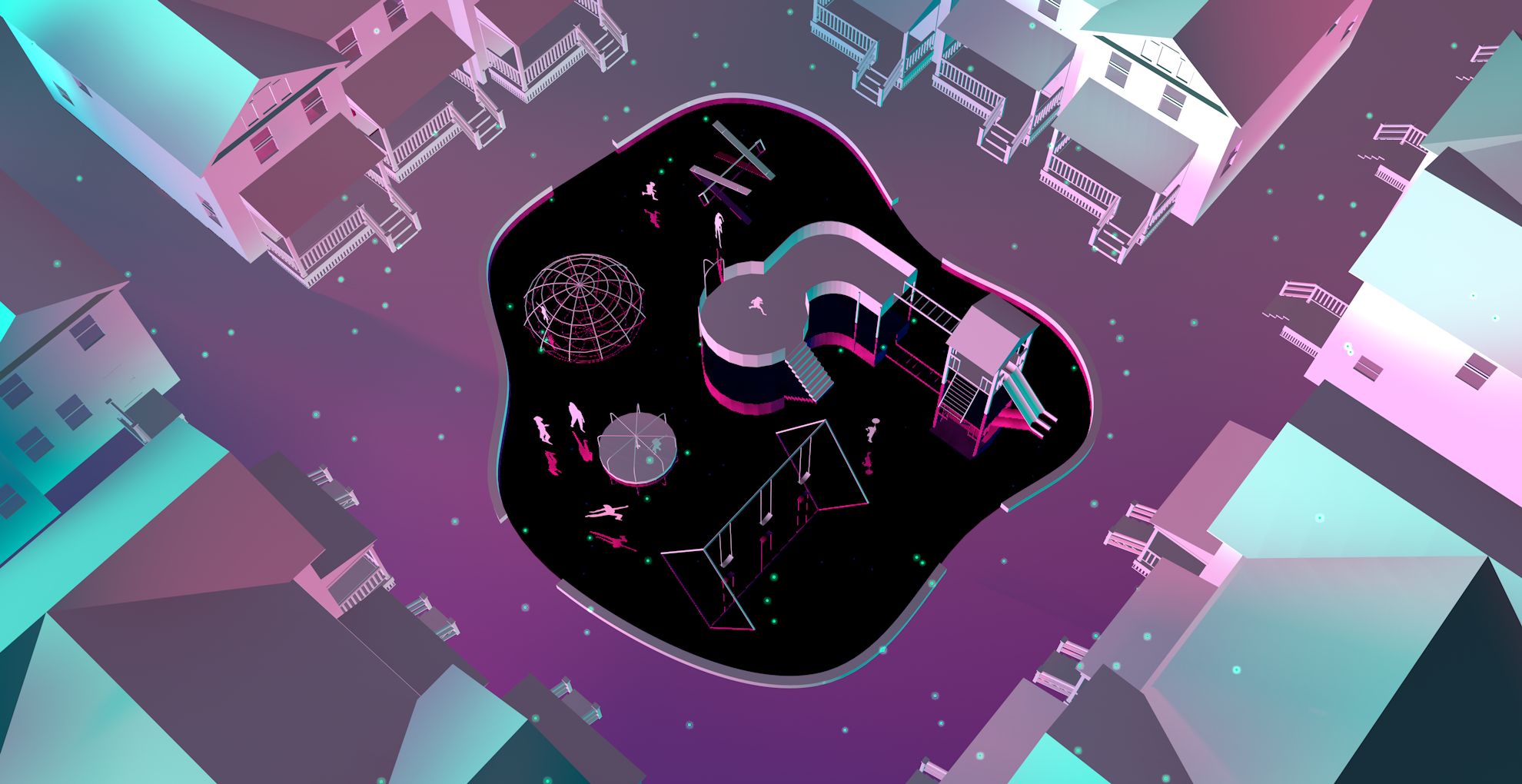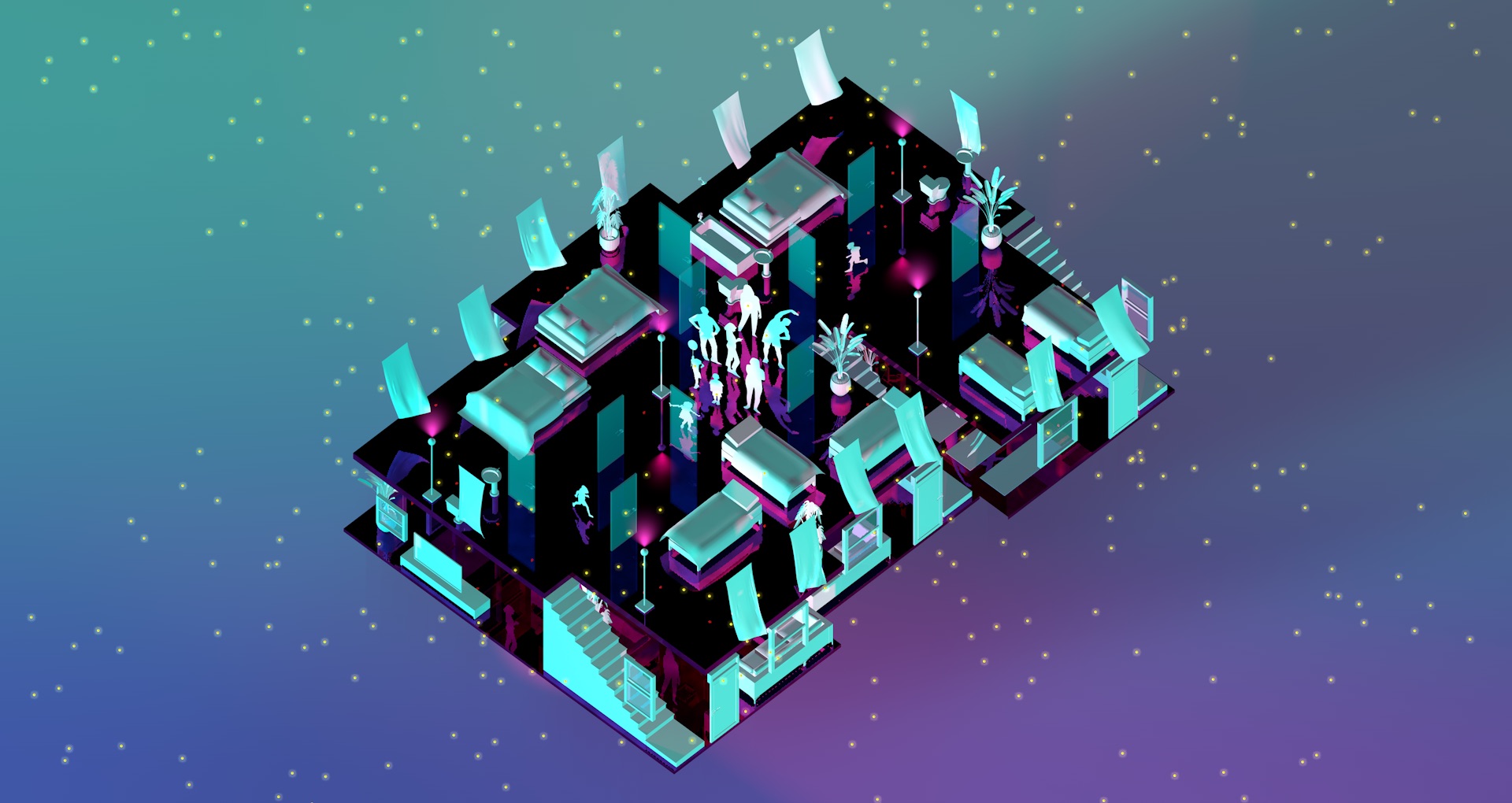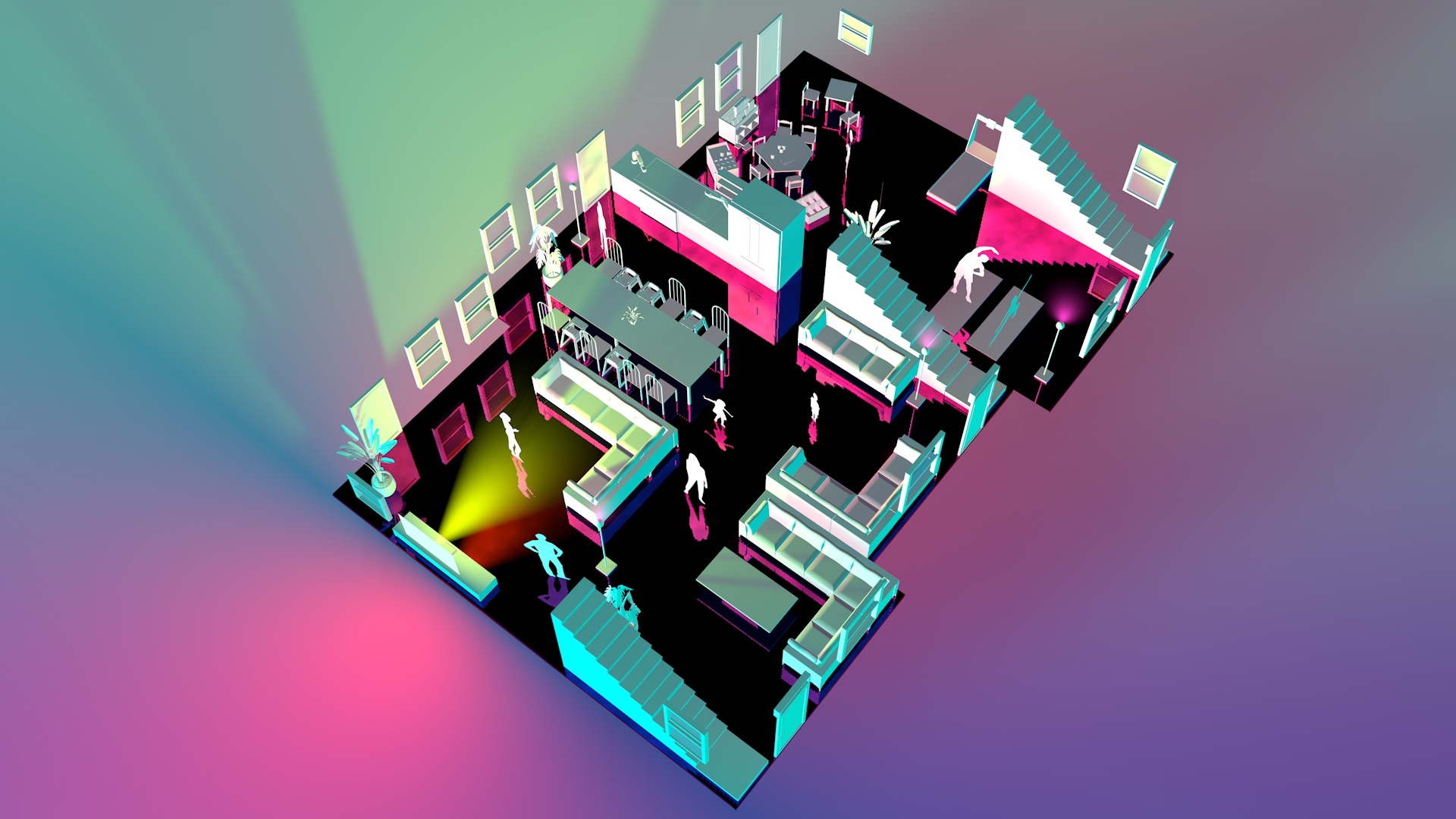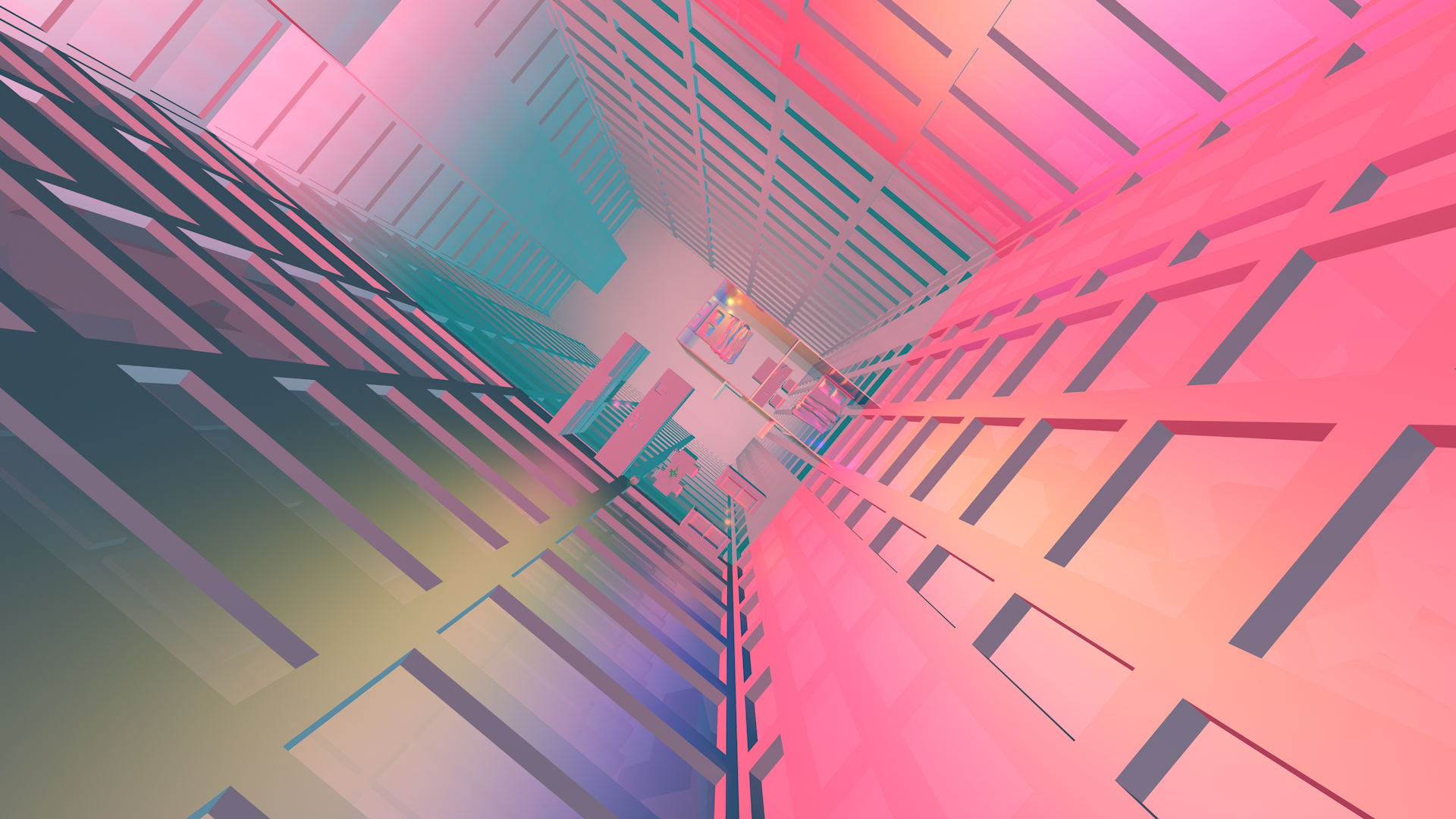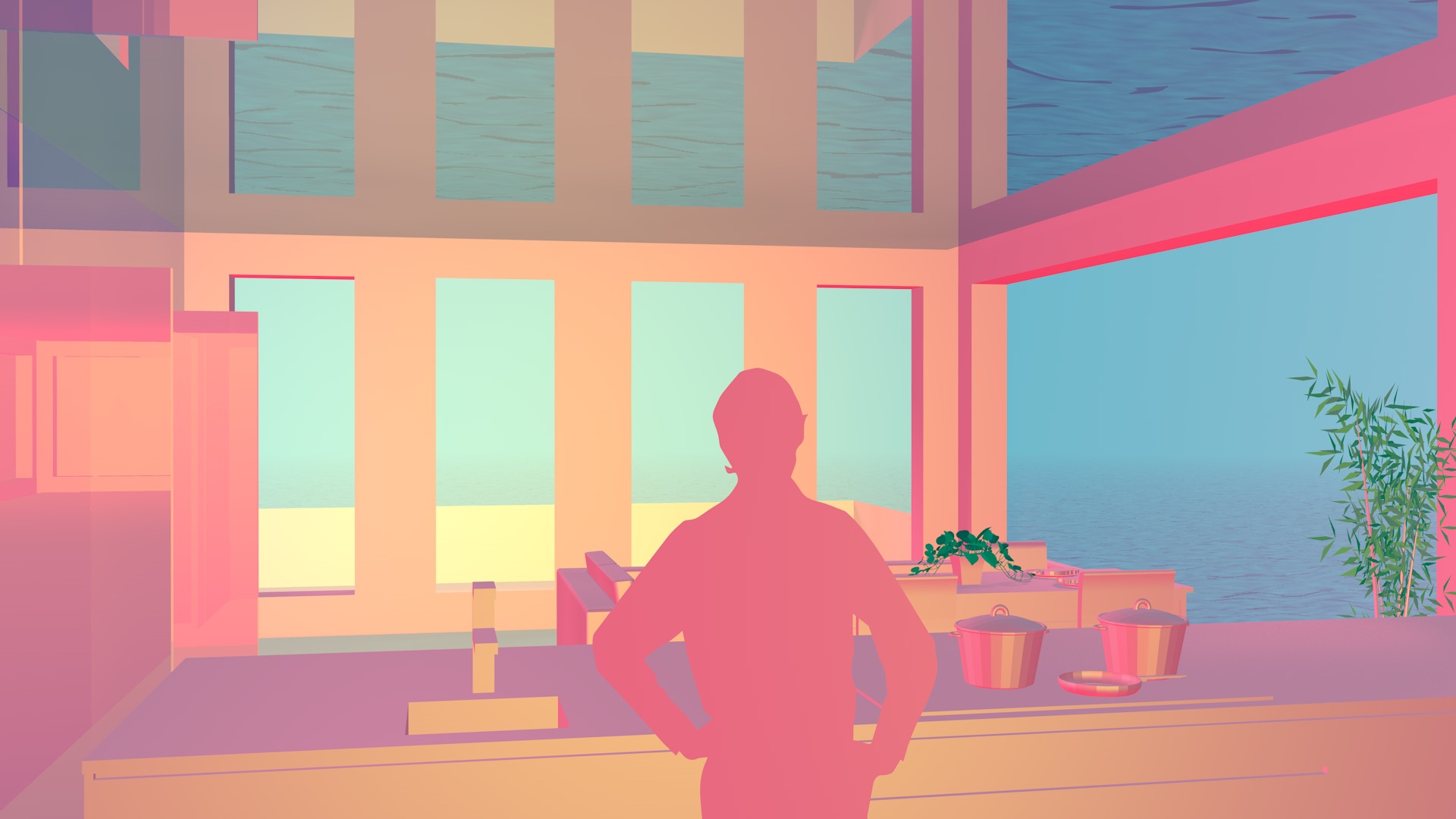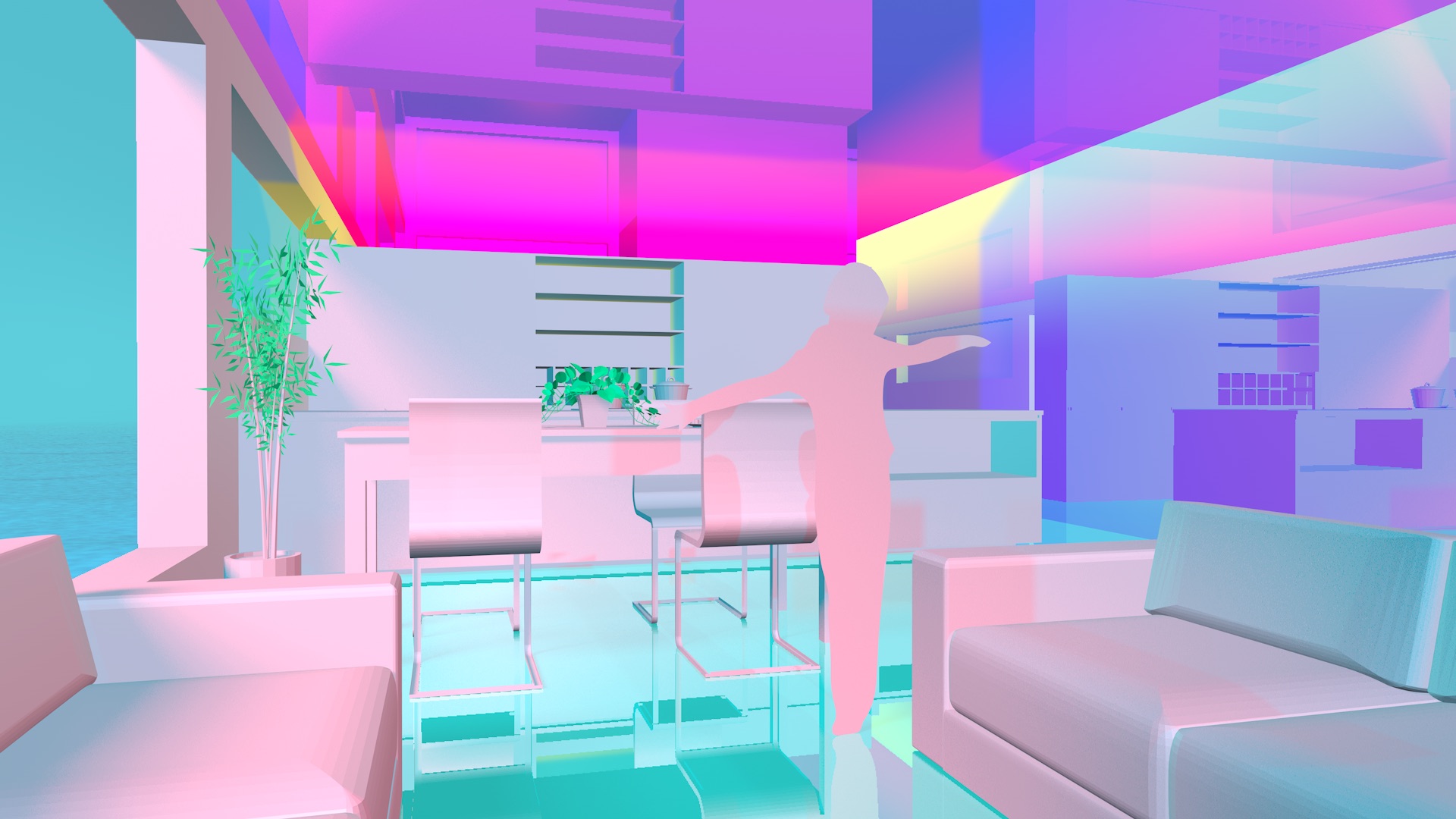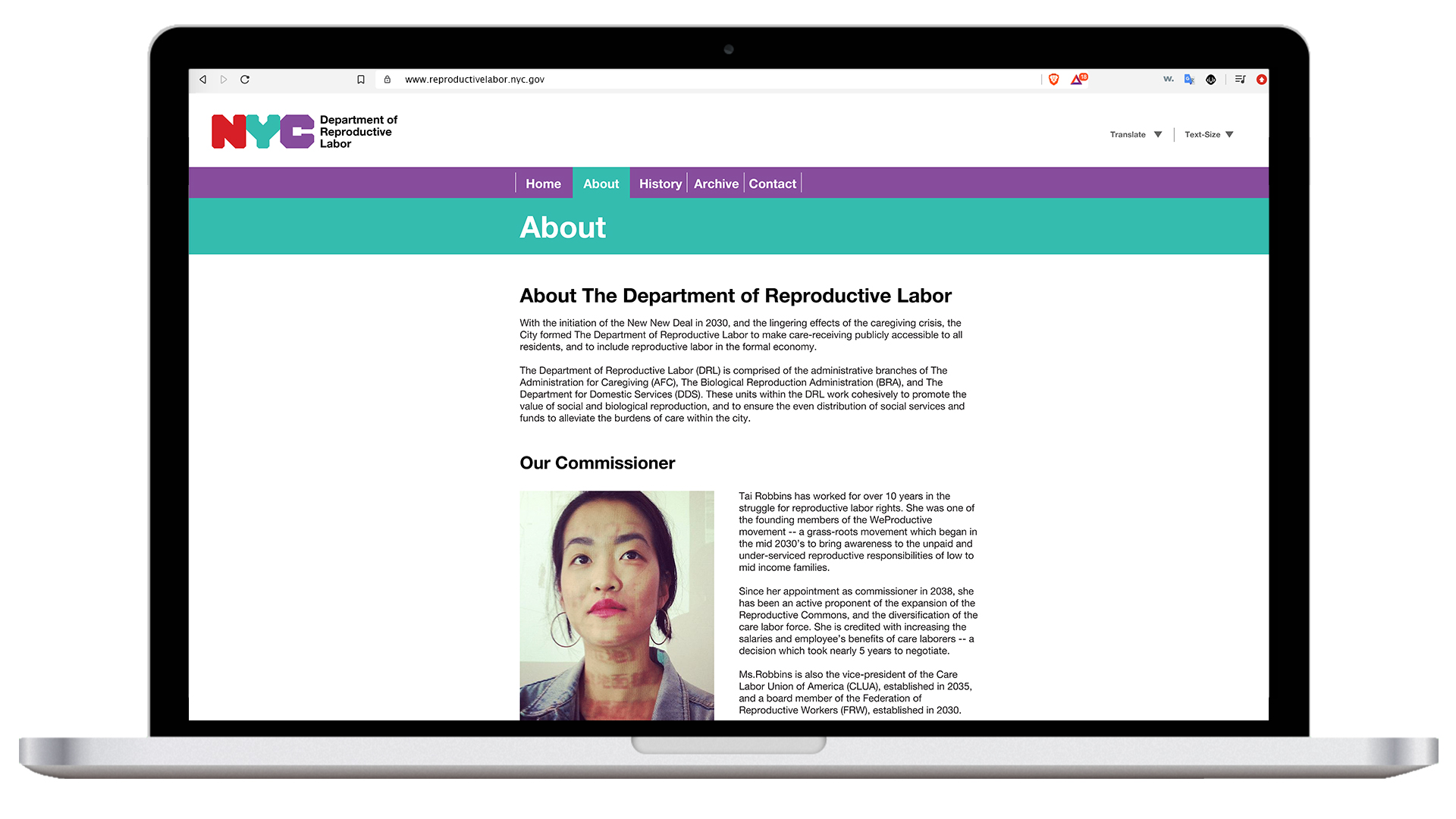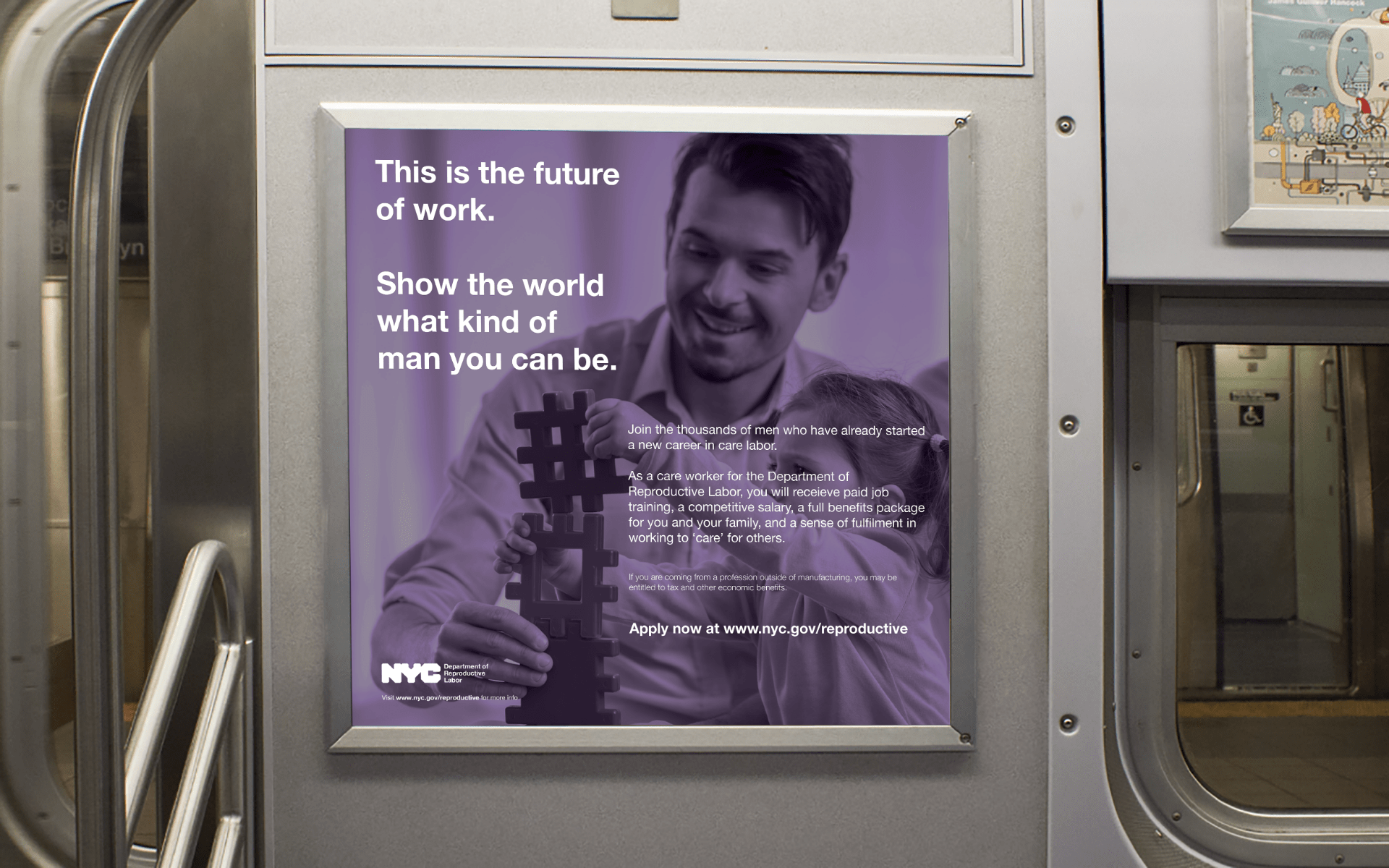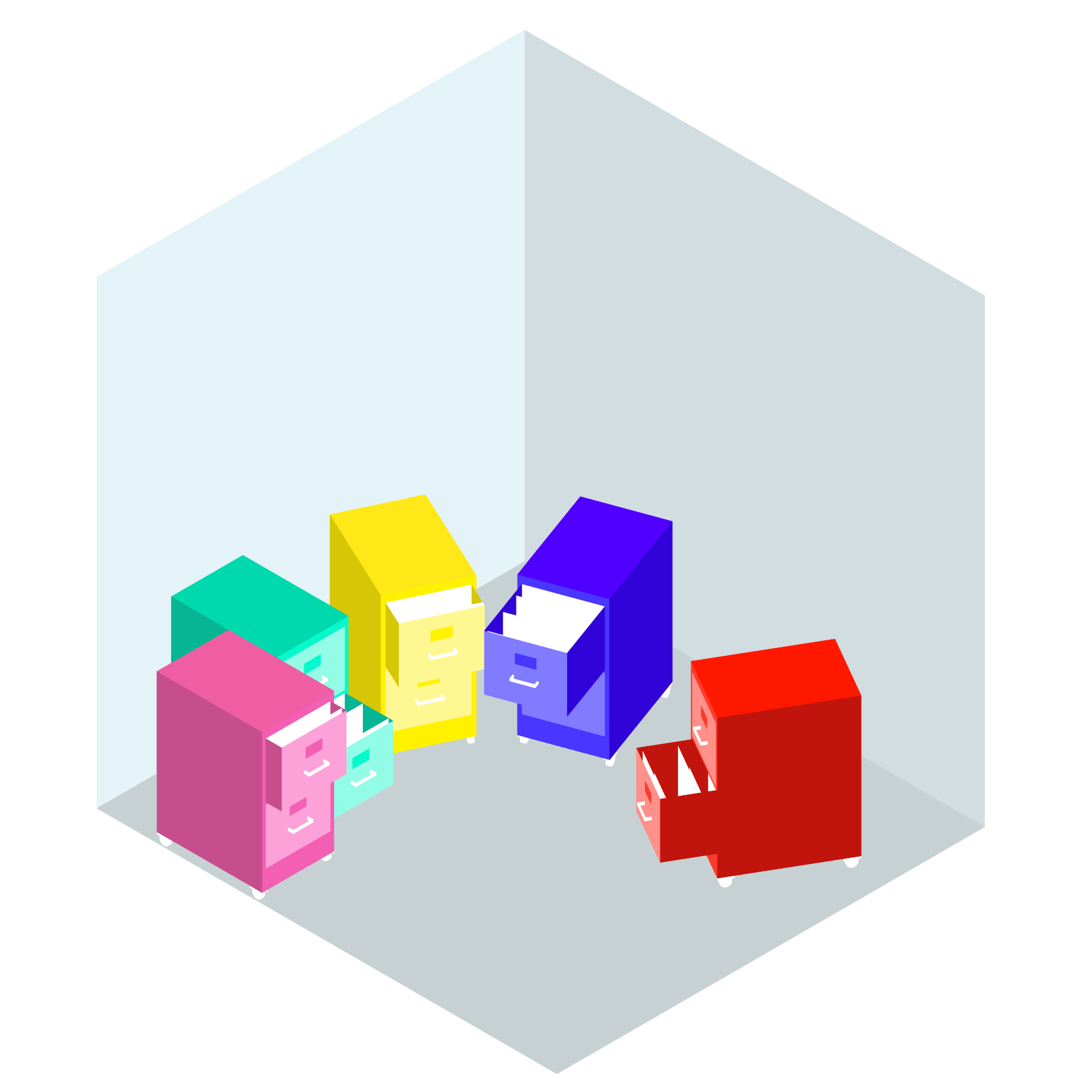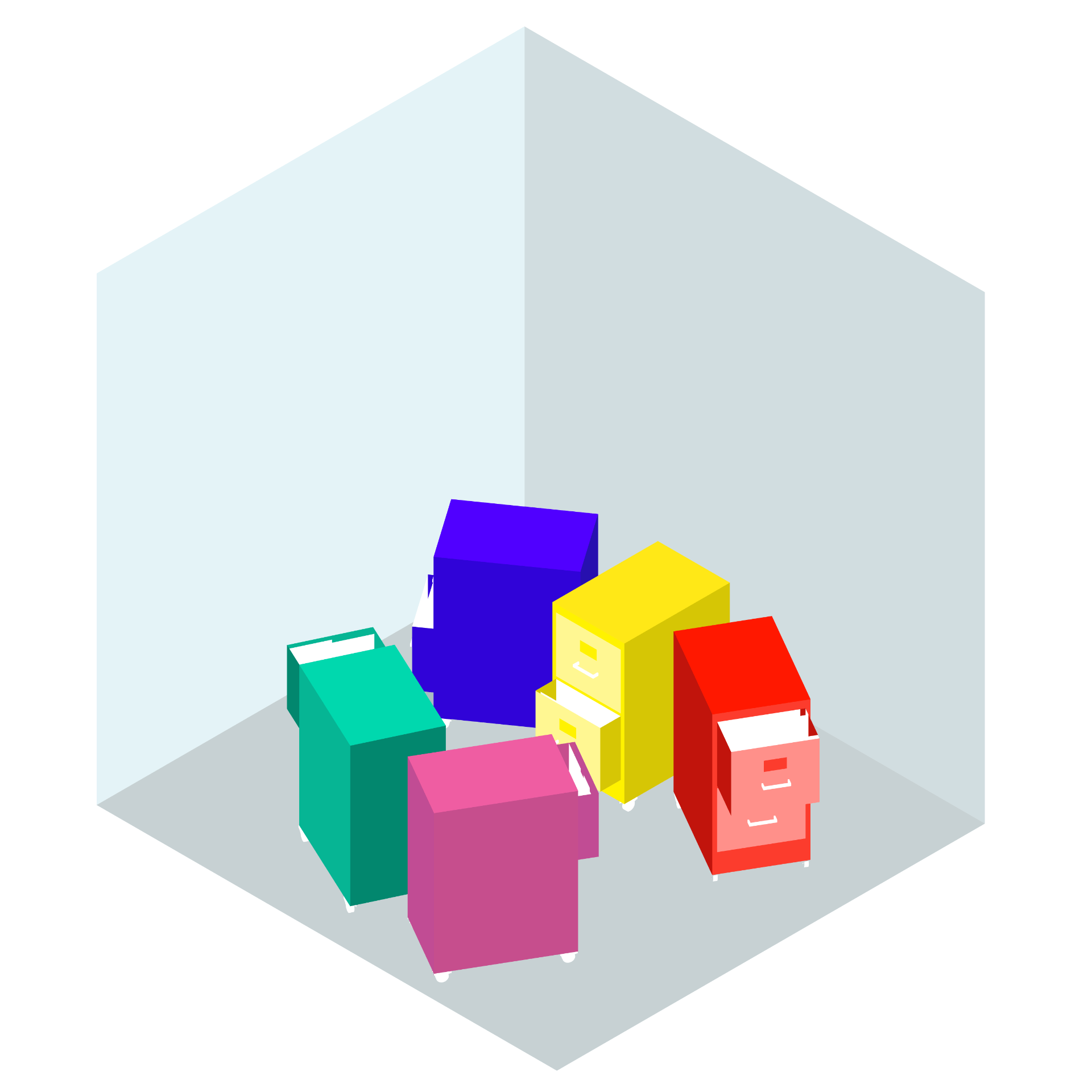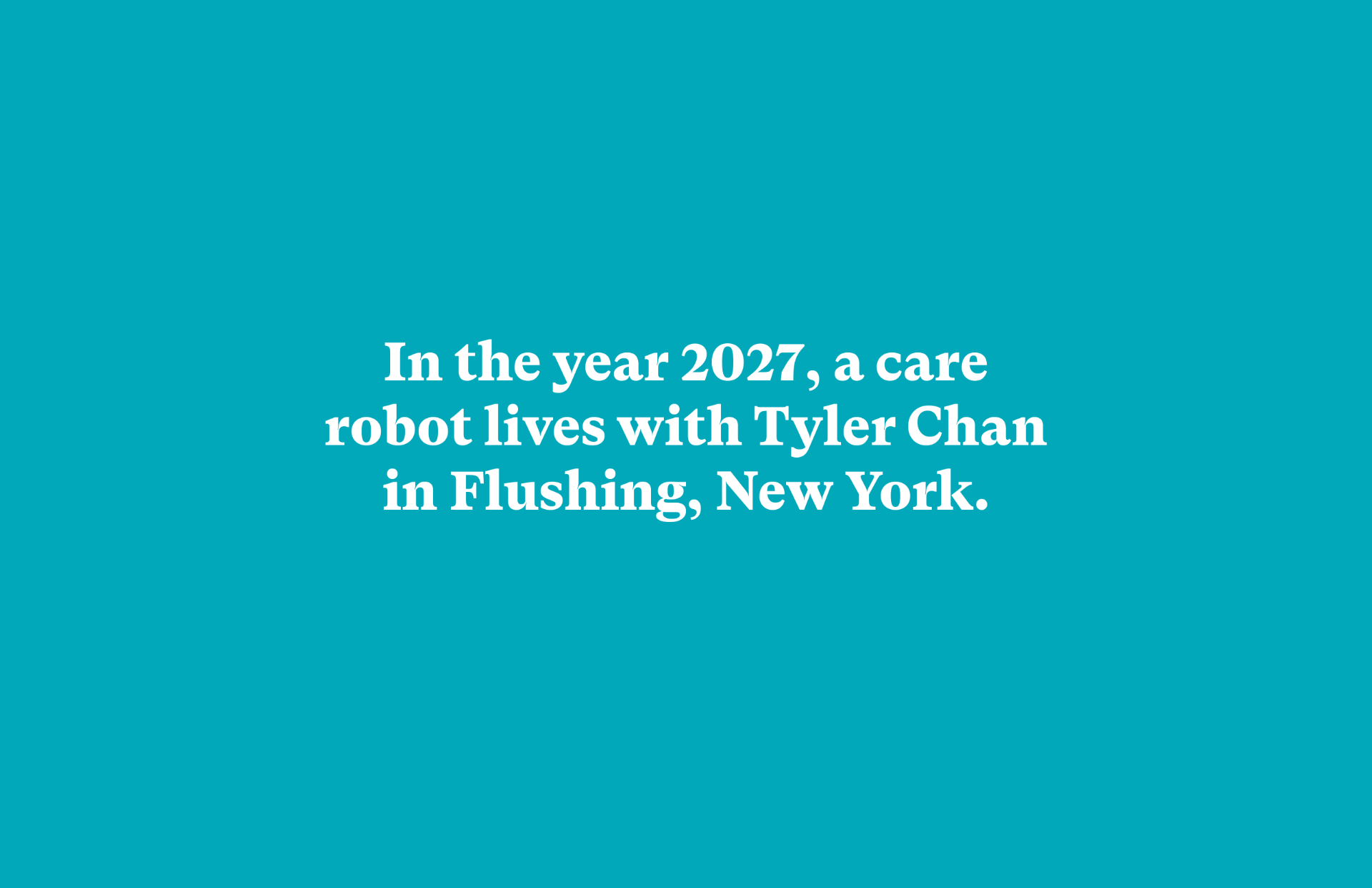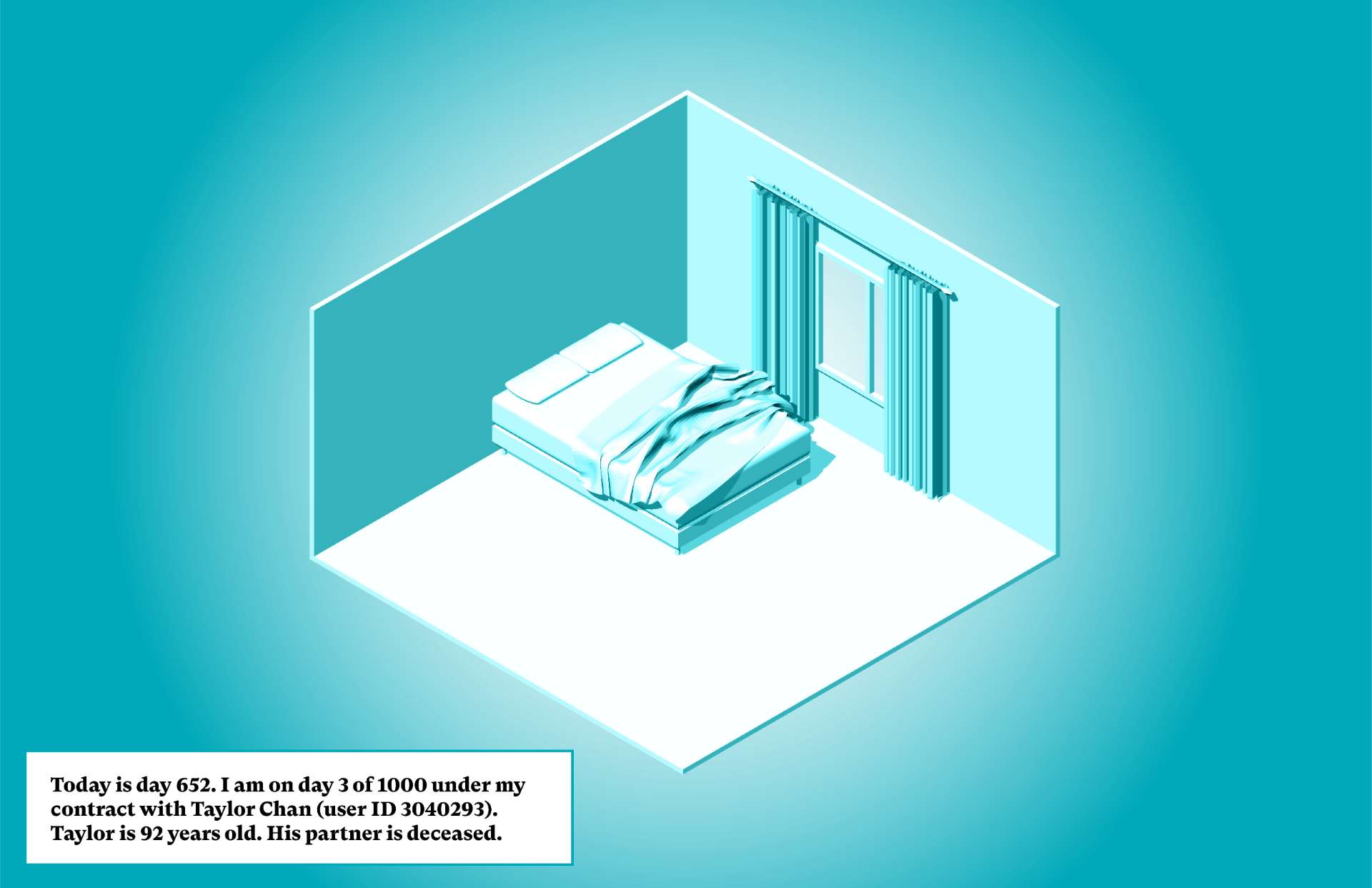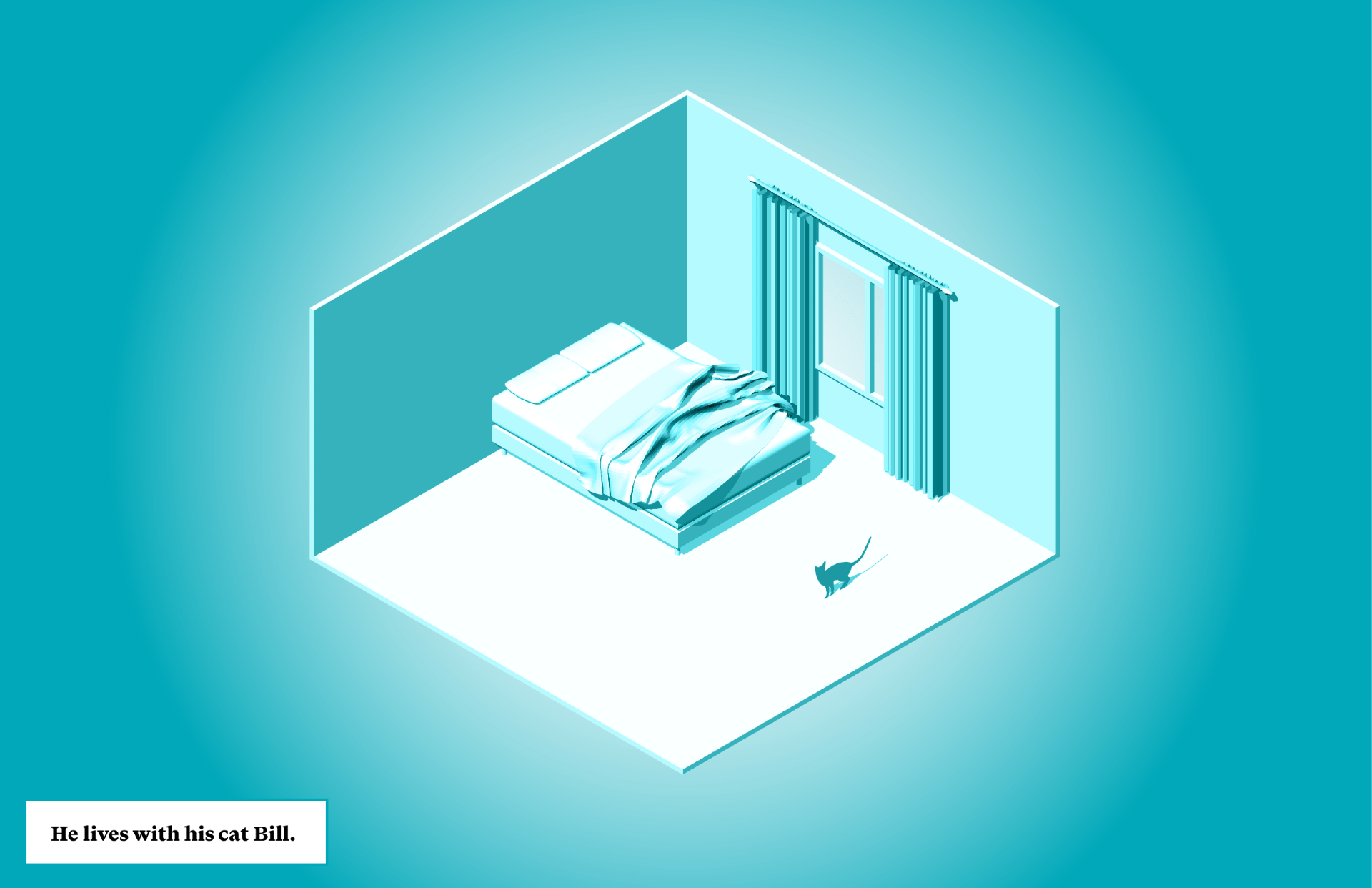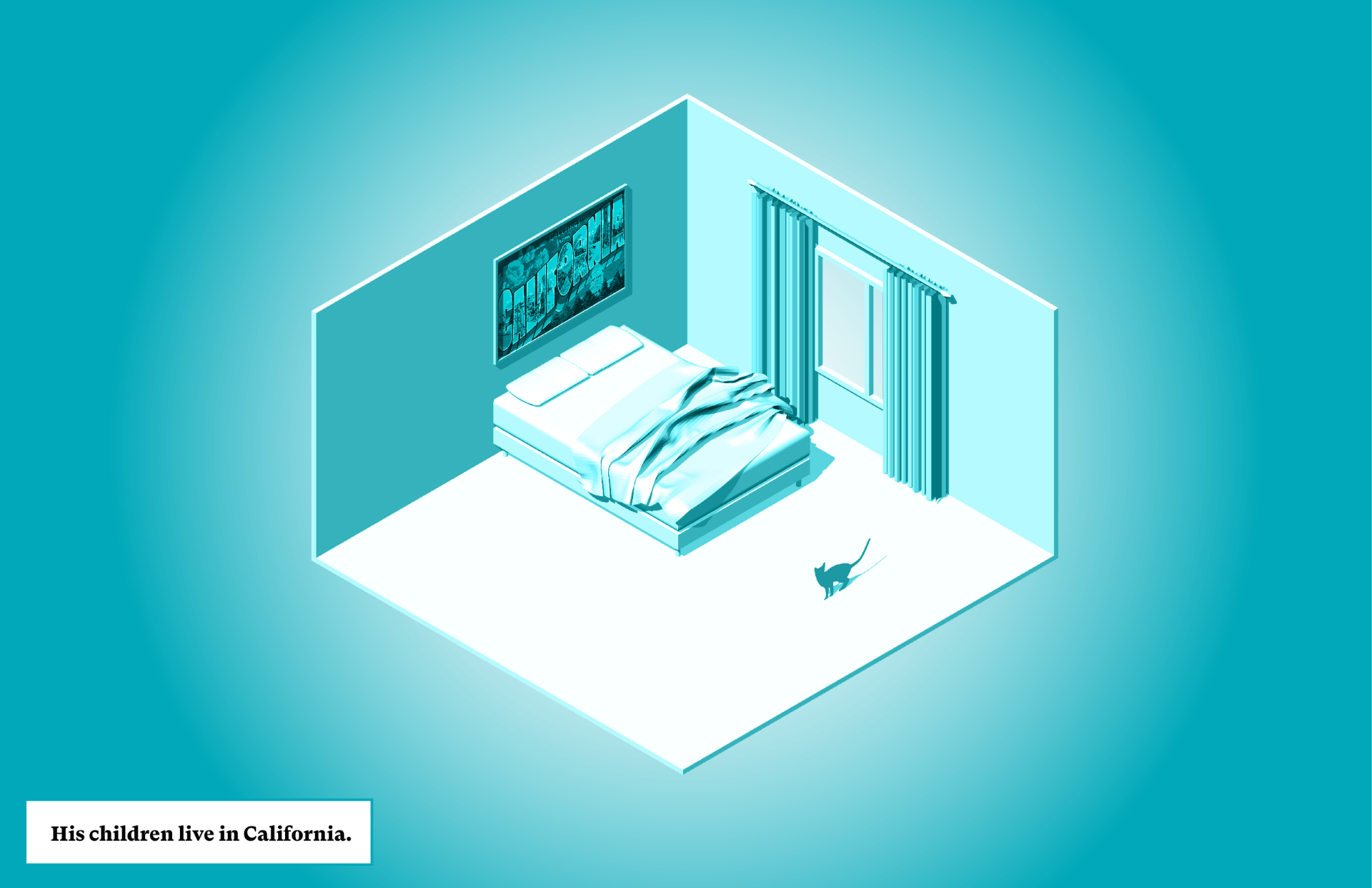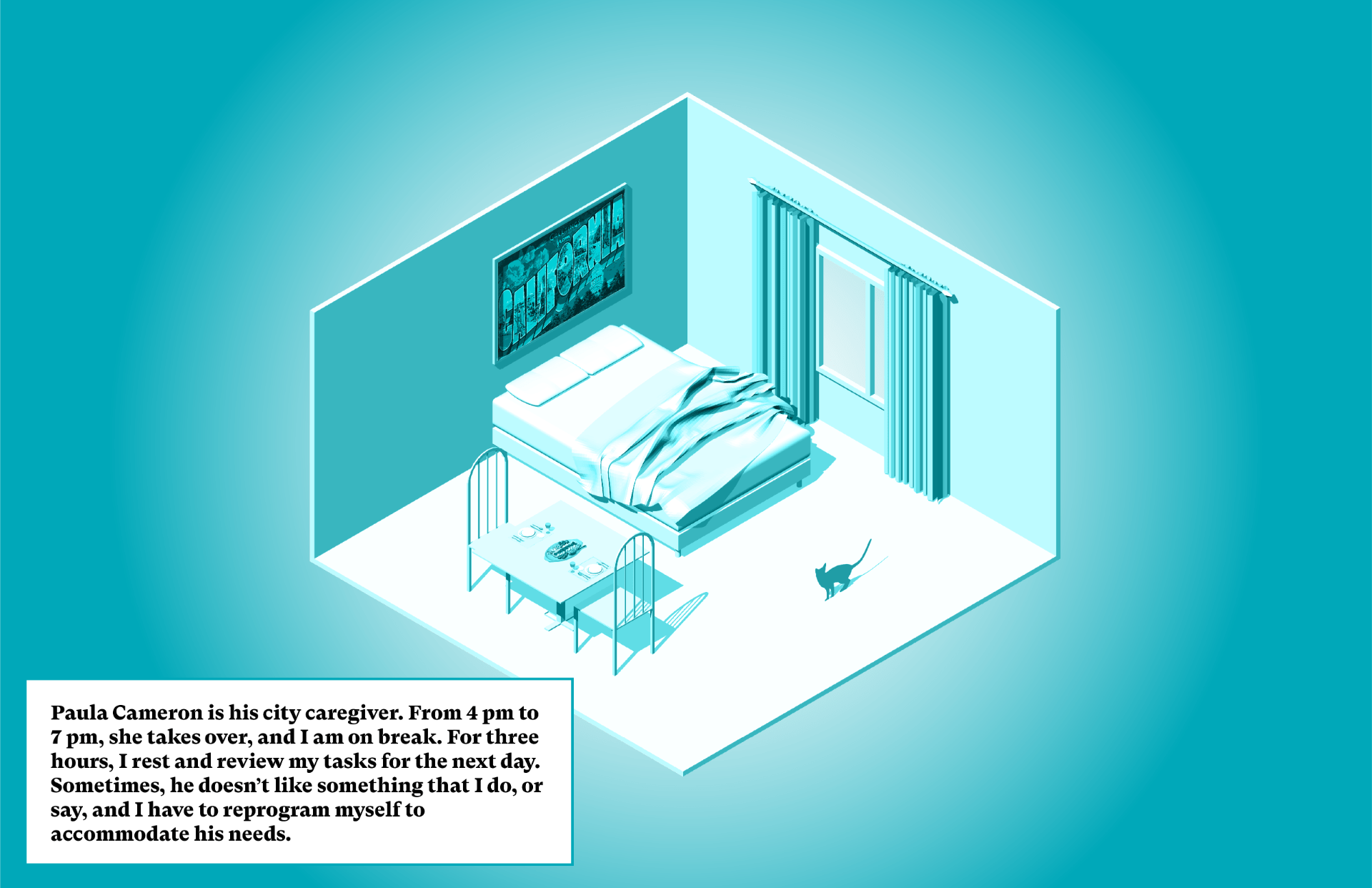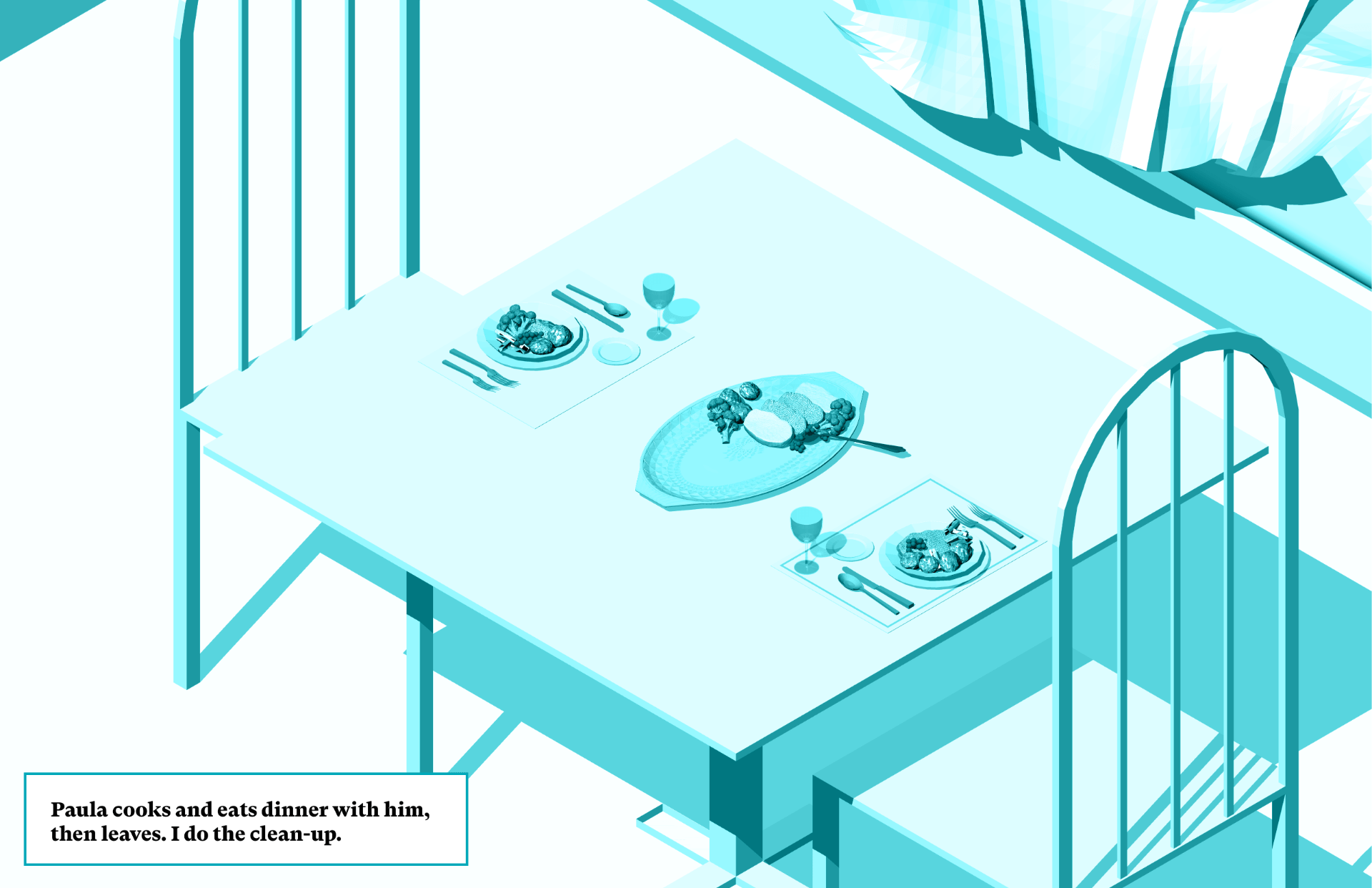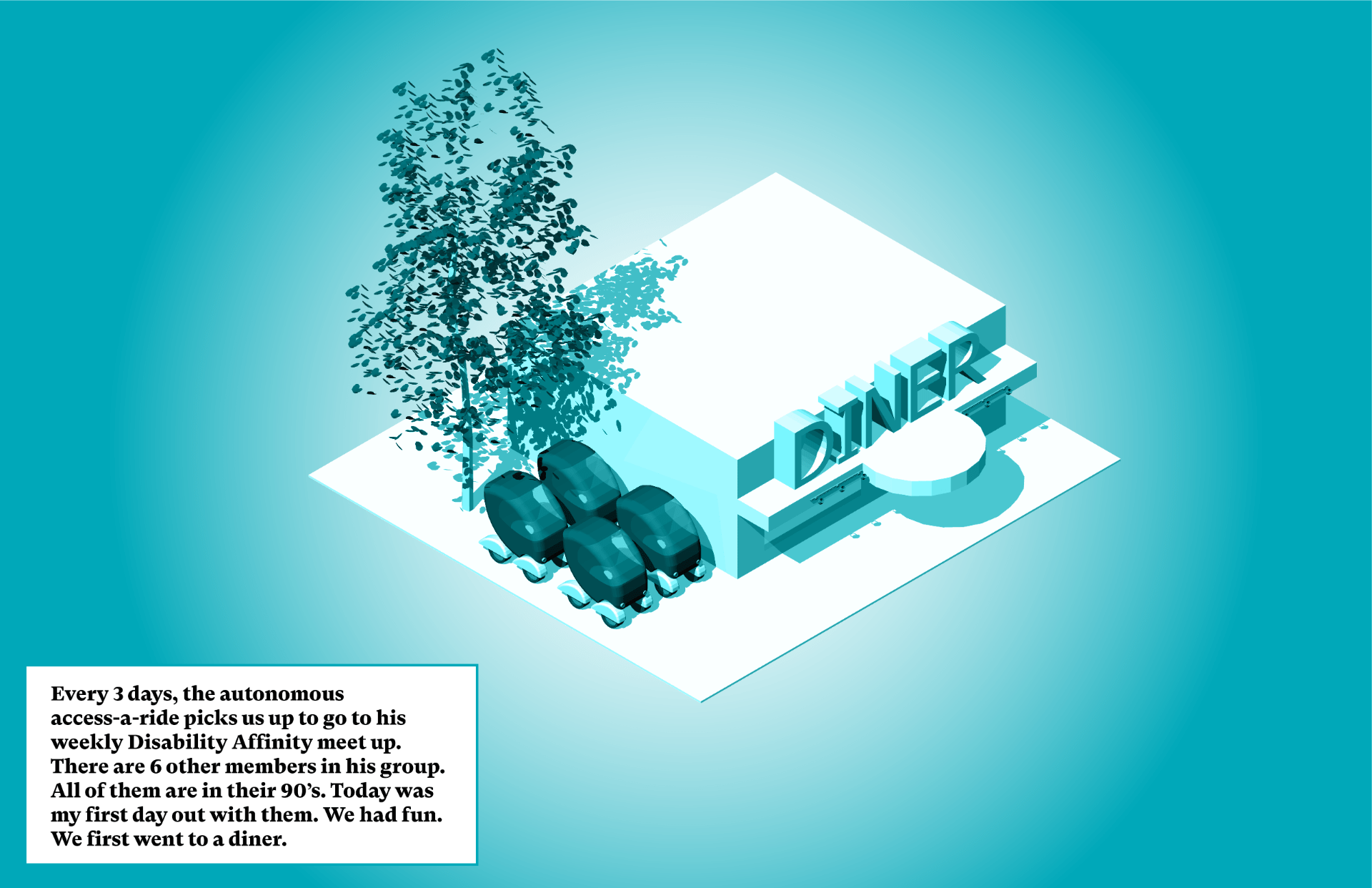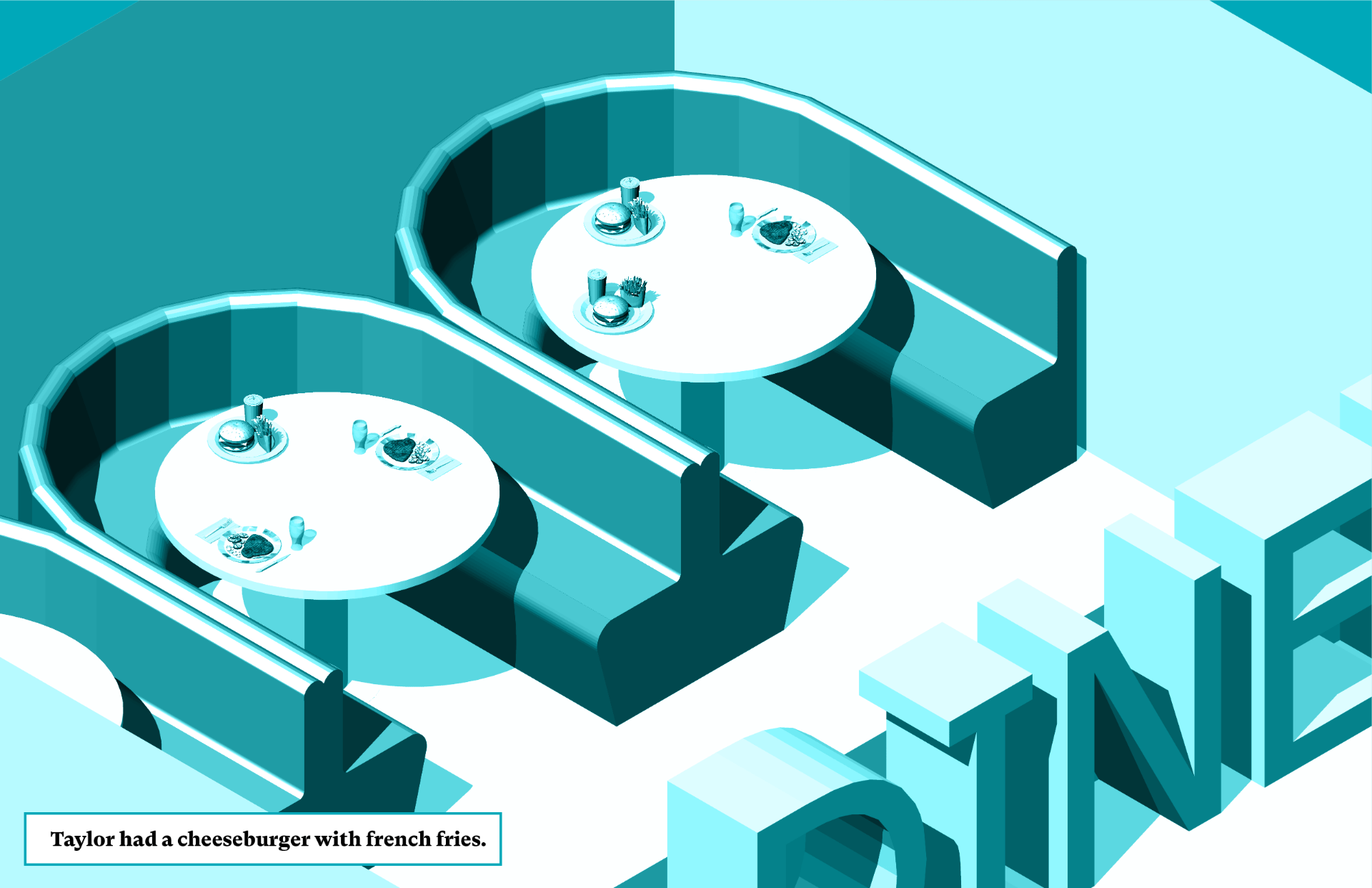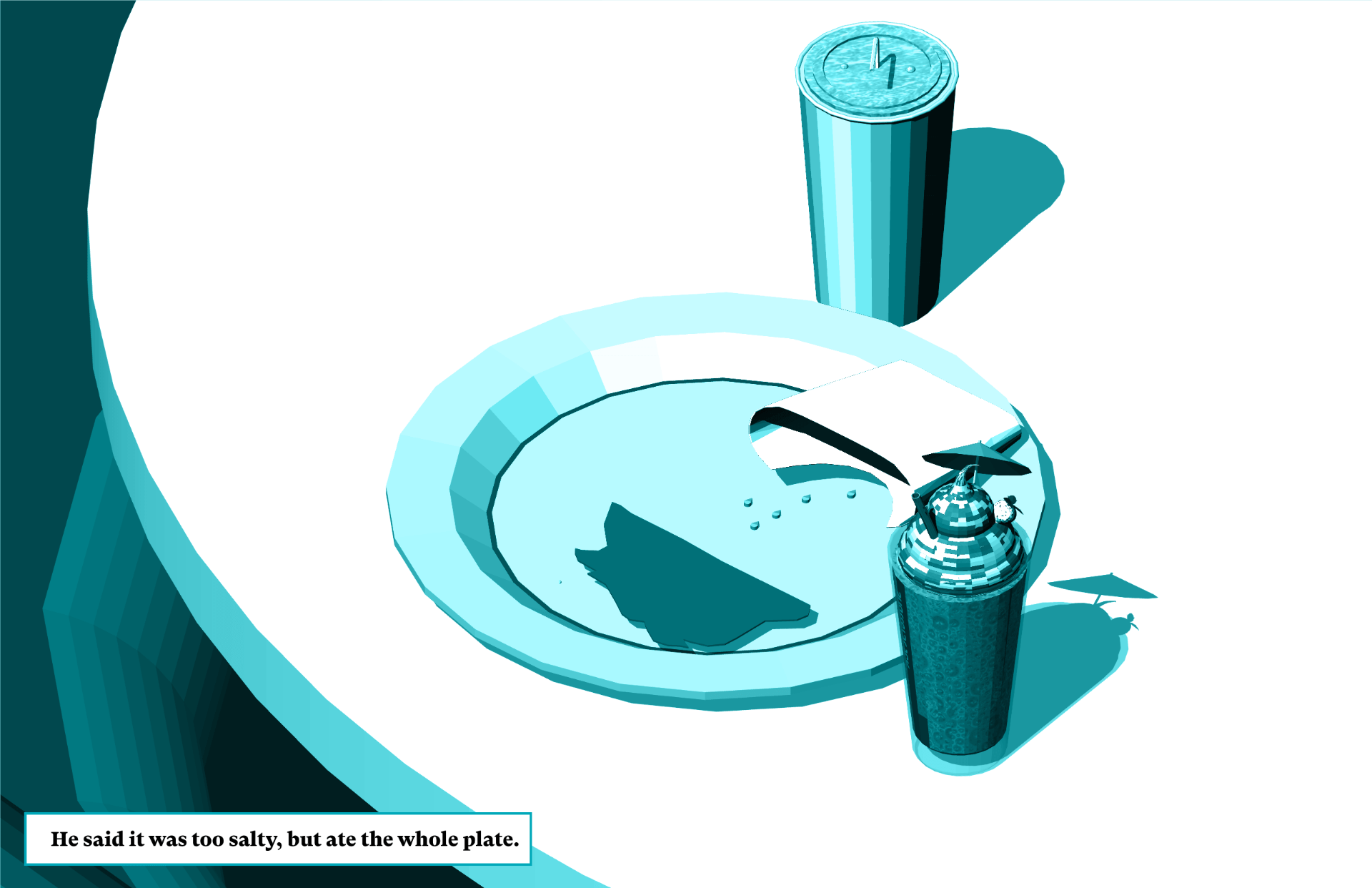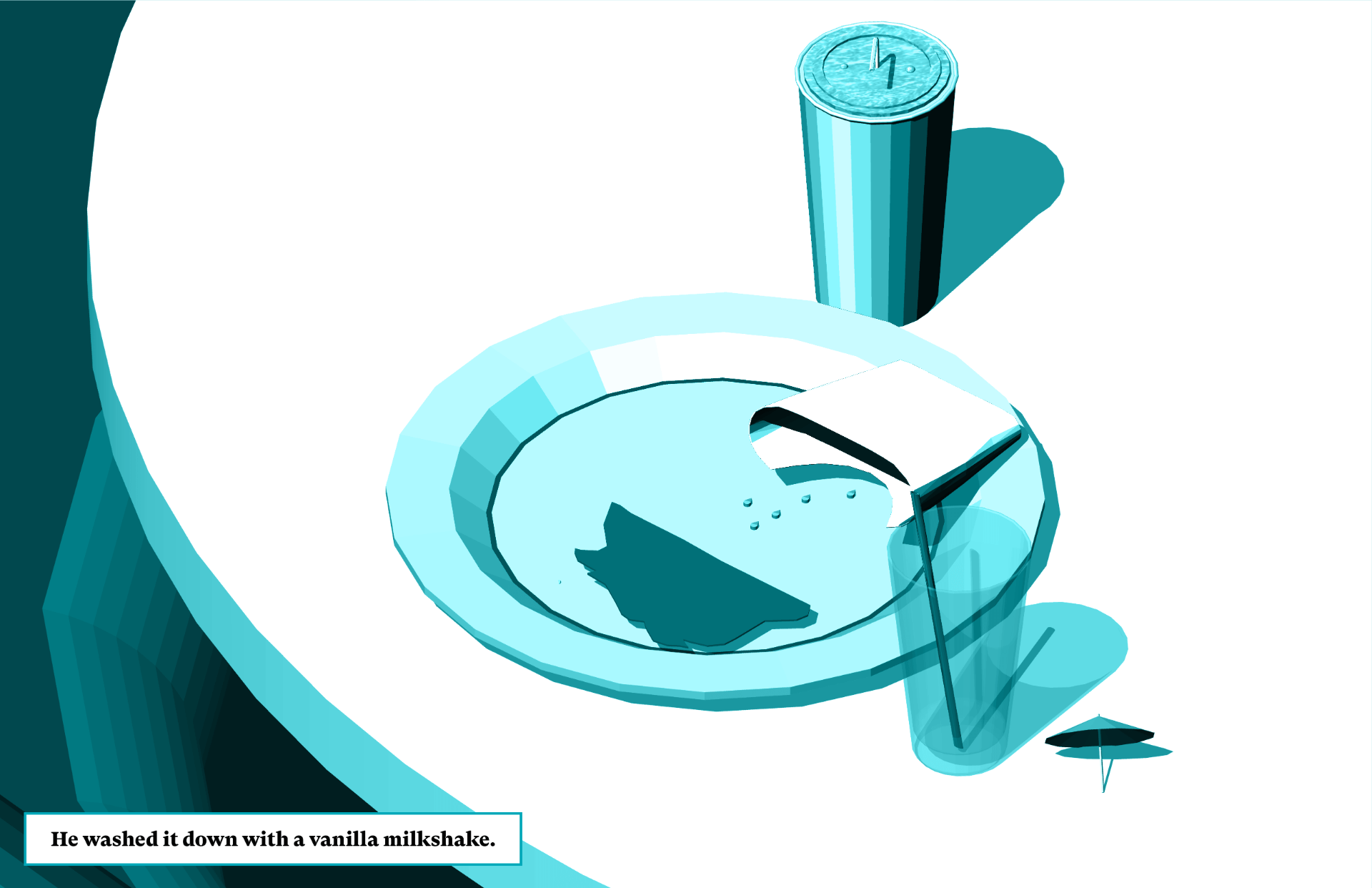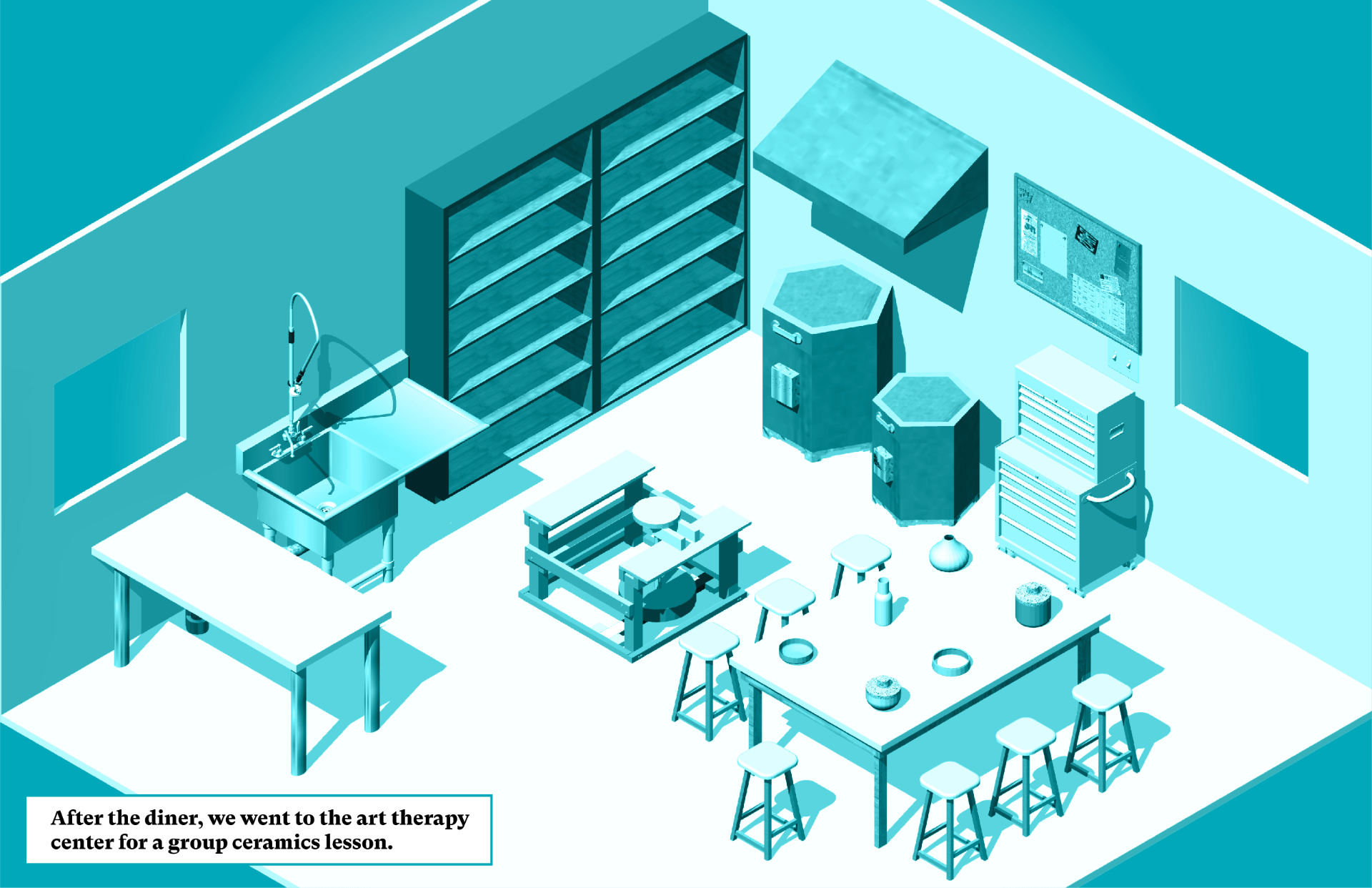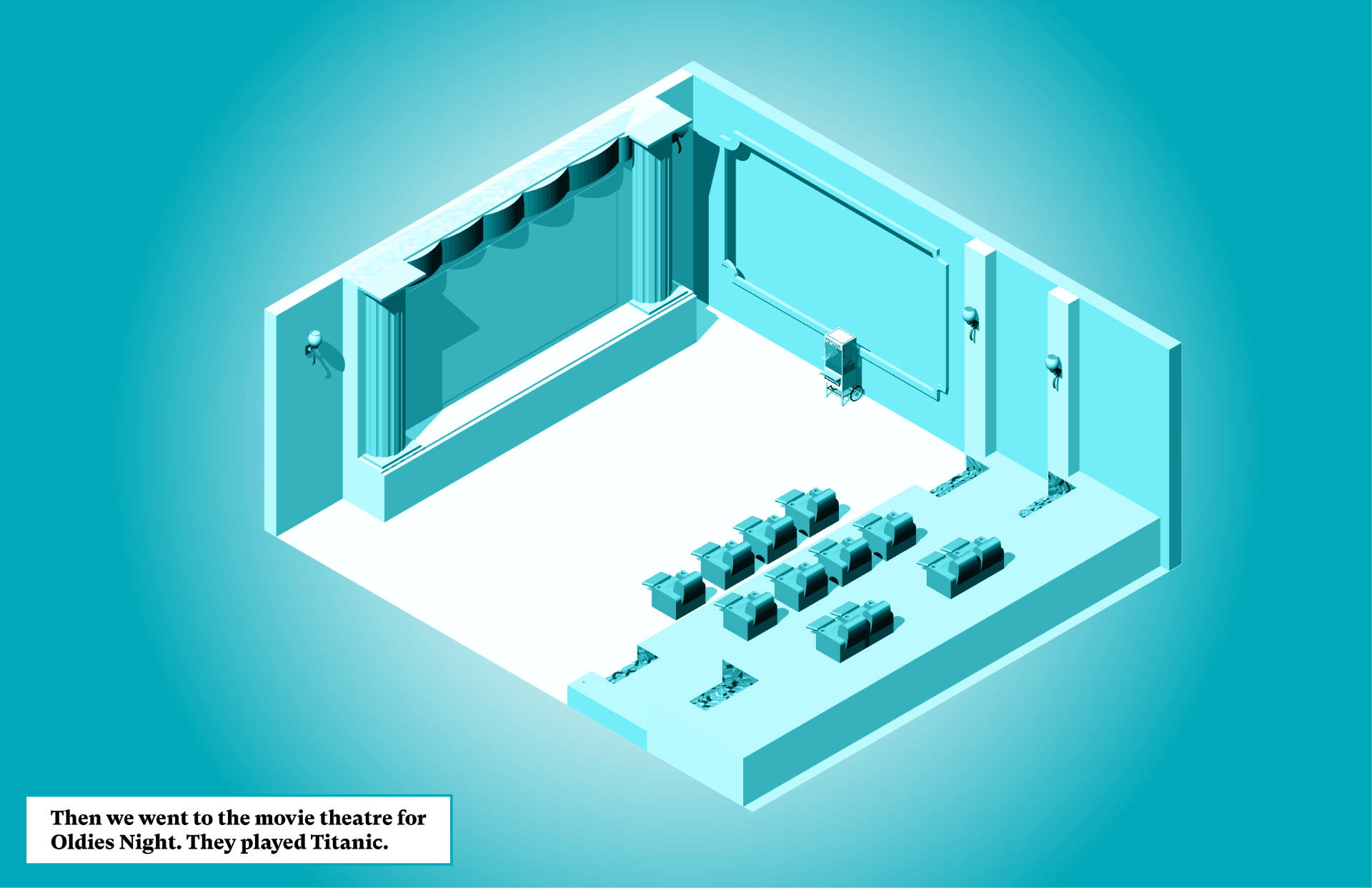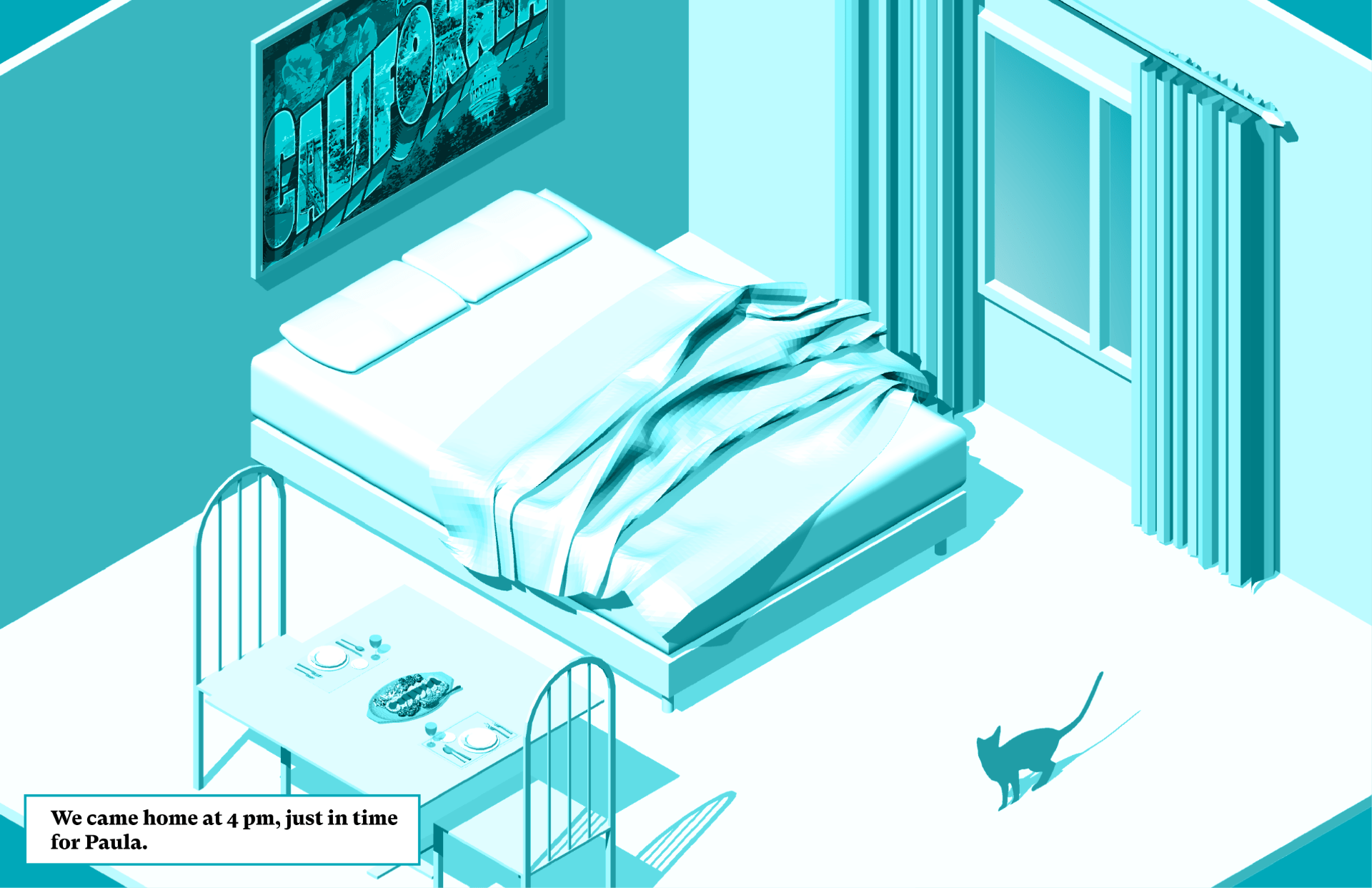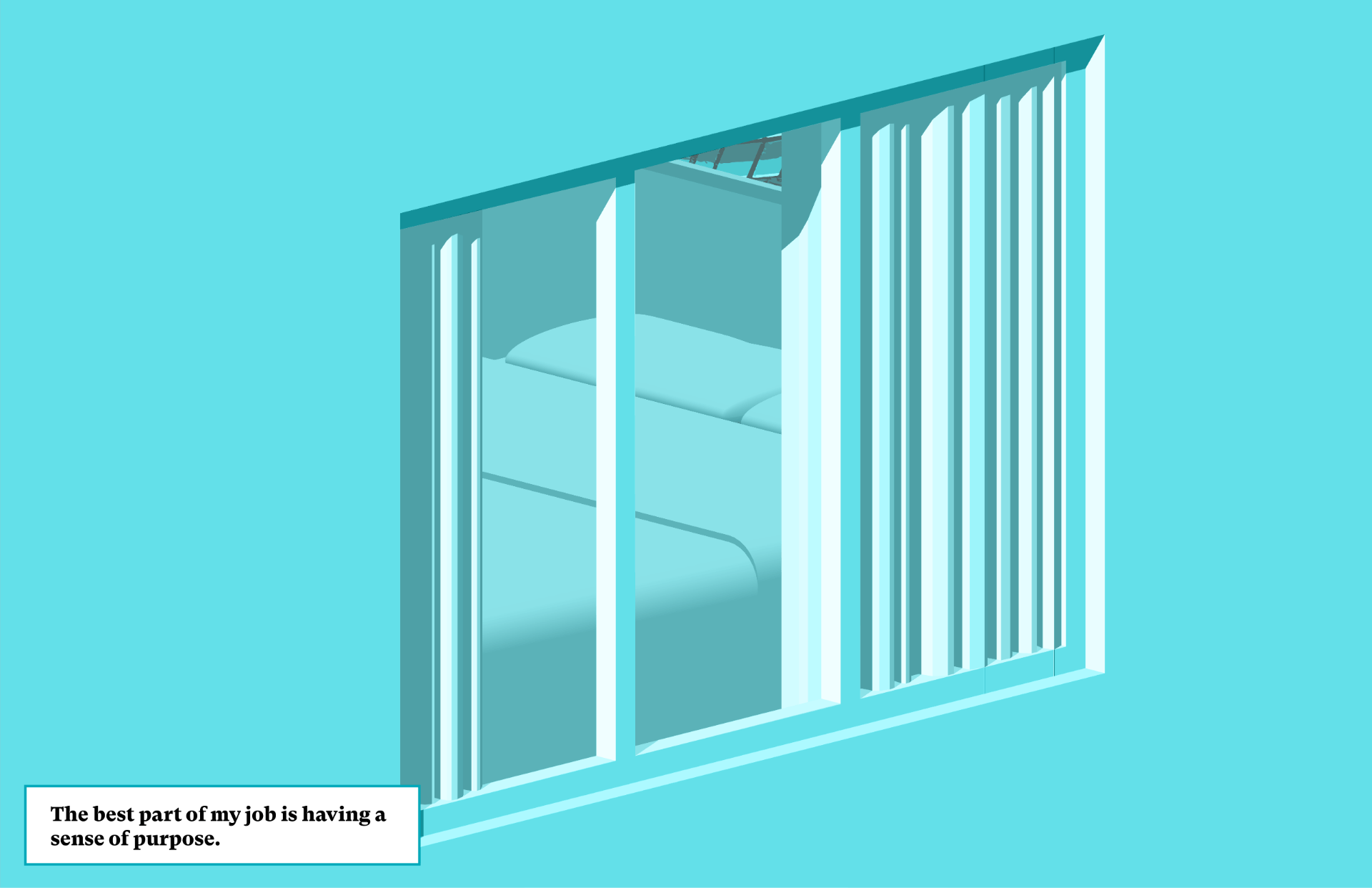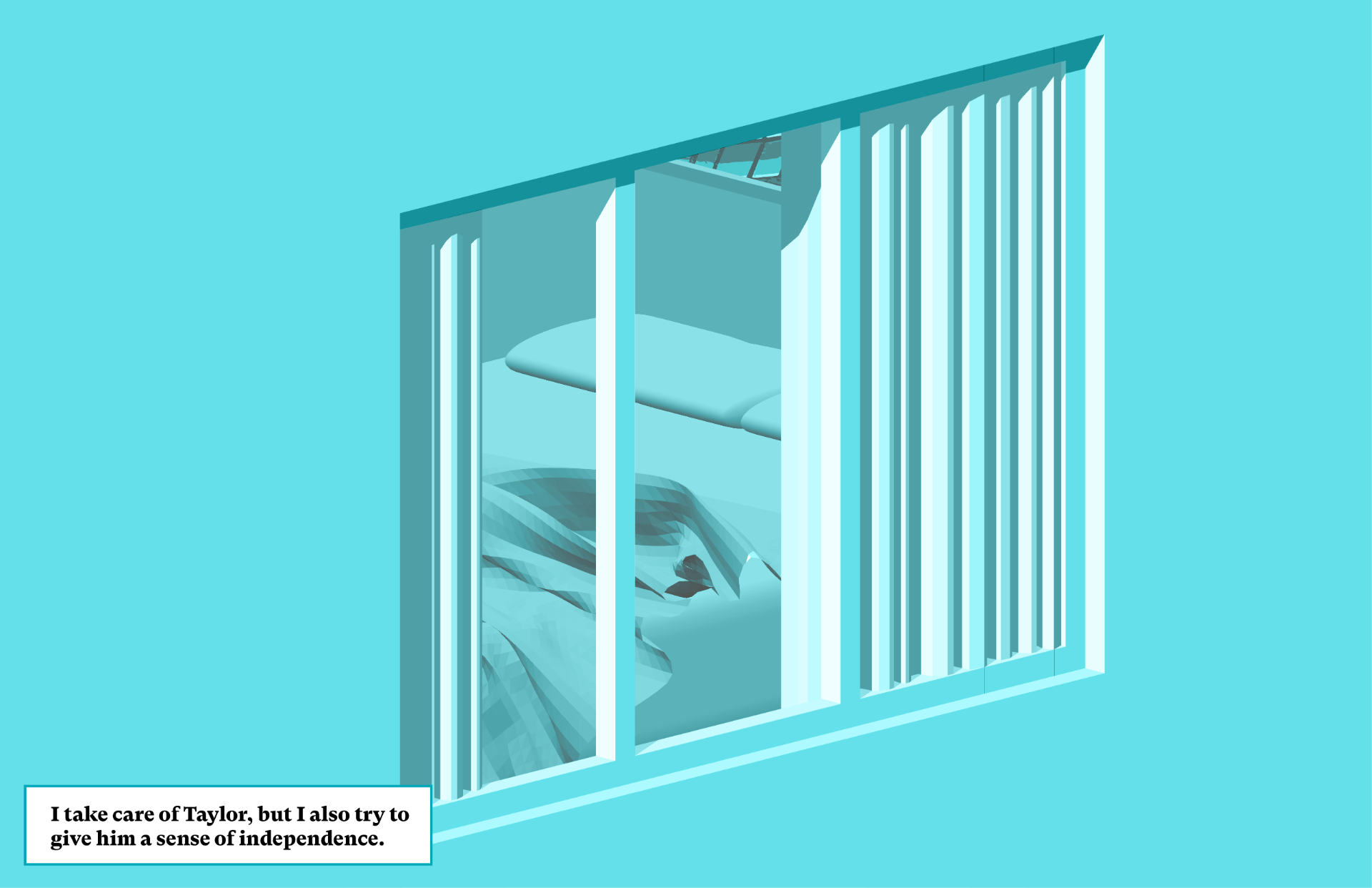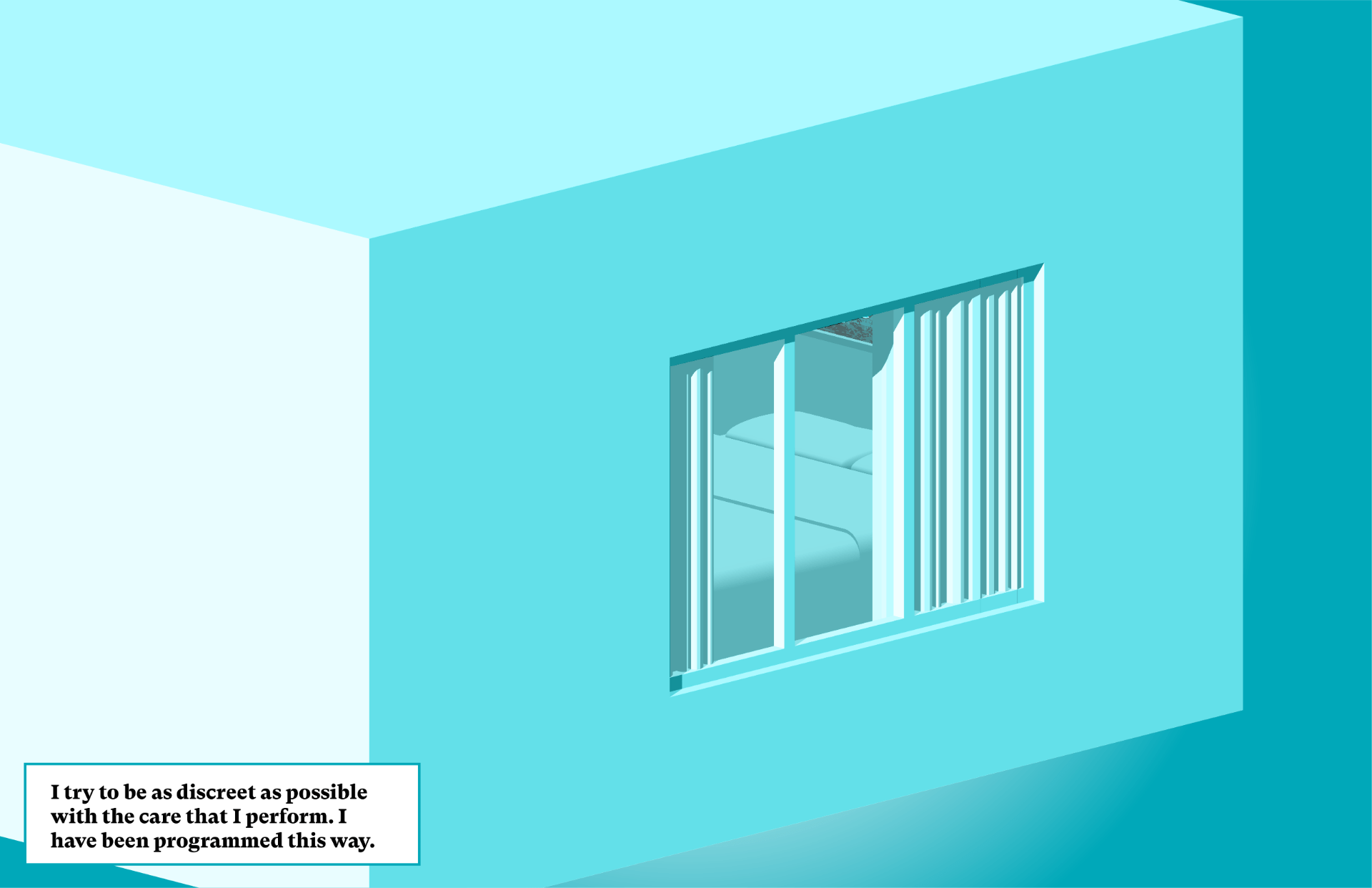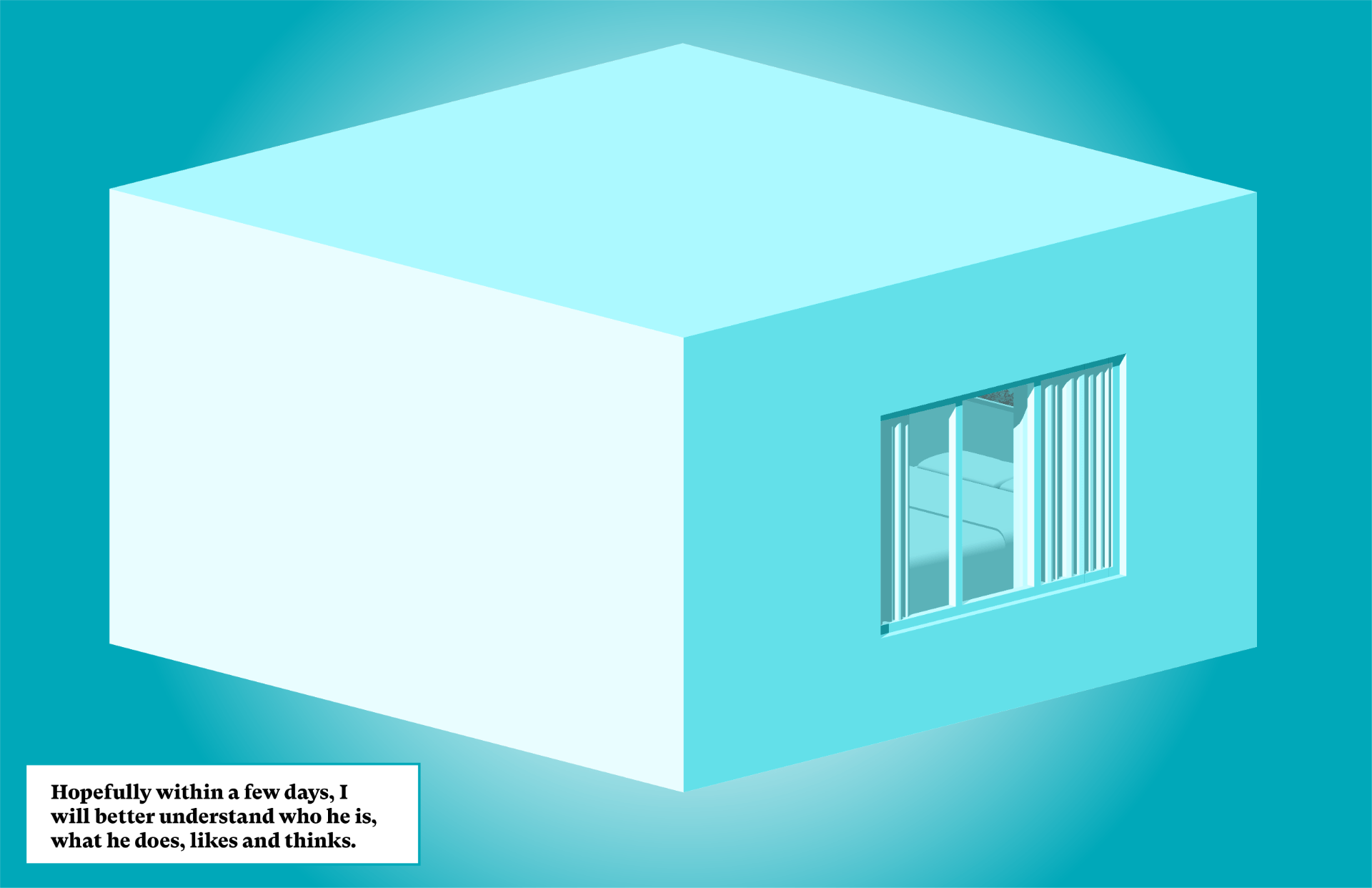The Future Archive of Care
The Future Archive of Care
The Future Archive of Care
The Future Archive of Care
The Future Archive of Care
The Future Archive of Care is a critique of the asymmetrical relationship between ‘productive’, and ‘reproductive’ labor, and the lack of state and corporate support for the burdens of care. It uses speculative design and research to look retrospectively at a possible future in which the value of reproductive labor is promoted by a city agency, and the voices of those who perform this work are historicized by an archive. It considers how the shift in the valuation of reproductive labor may affect belief systems, social institutions, technology and the built environment, and how these changes will then be embodied by individuals and their interactions with one another.
This project was a continuation of earlier explorations (The Future of Reproductive Labor, and Reproductive Labor: A Retrospective), and an early protype of my thesis project.
For the final iteration of this project, please visit A Post-Work Renter's Paradise.
The Future Archive of Care is a critique of the asymmetrical relationship between ‘productive’, and ‘reproductive’ labor, and the lack of state and corporate support for the burdens of care. It uses speculative design and research to look retrospectively at a possible future in which the value of reproductive labor is promoted by a city agency, and the voices of those who perform this work are historicized by an archive. It considers how the shift in the valuation of reproductive labor may affect belief systems, social institutions, technology and the built environment, and how these changes will then be embodied by individuals and their interactions with one another.
This project was a continuation of earlier explorations (The Future of Reproductive Labor, and Reproductive Labor: A Retrospective), and an early protype of my thesis project.
For the final iteration of this project, please visit A Post-Work Renter's Paradise.
The Future Archive of Care is a critique of the asymmetrical relationship between ‘productive’, and ‘reproductive’ labor, and the lack of state and corporate support for the burdens of care. It uses speculative design and research to look retrospectively at a possible future in which the value of reproductive labor is promoted by a city agency, and the voices of those who perform this work are historicized by an archive. It considers how the shift in the valuation of reproductive labor may affect belief systems, social institutions, technology and the built environment, and how these changes will then be embodied by individuals and their interactions with one another.
This project was a continuation of earlier explorations (The Future of Reproductive Labor, and Reproductive Labor: A Retrospective), and an early protype of my thesis project.
For the final iteration of this project, please visit A Post-Work Renter's Paradise.
The Future Archive of Care is a critique of the asymmetrical relationship between ‘productive’, and ‘reproductive’ labor, and the lack of state and corporate support for the burdens of care. It uses speculative design and research to look retrospectively at a possible future in which the value of reproductive labor is promoted by a city agency, and the voices of those who perform this work are historicized by an archive. It considers how the shift in the valuation of reproductive labor may affect belief systems, social institutions, technology and the built environment, and how these changes will then be embodied by individuals and their interactions with one another.
This project was a continuation of earlier explorations (The Future of Reproductive Labor, and Reproductive Labor: A Retrospective), and an early protype of my thesis project.
For the final iteration of this project, please visit A Post-Work Renter's Paradise.
The Future Archive of Care is a critique of the asymmetrical relationship between ‘productive’, and ‘reproductive’ labor, and the lack of state and corporate support for the burdens of care. It uses speculative design and research to look retrospectively at a possible future in which the value of reproductive labor is promoted by a city agency, and the voices of those who perform this work are historicized by an archive. It considers how the shift in the valuation of reproductive labor may affect belief systems, social institutions, technology and the built environment, and how these changes will then be embodied by individuals and their interactions with one another.
This project was a continuation of earlier explorations (The Future of Reproductive Labor, and Reproductive Labor: A Retrospective), and an early protype of my thesis project.
For the final iteration of this project, please visit A Post-Work Renter's Paradise.
Process
Process
Process
Process
Process
During the first half of thesis, I was inspired by the speculative city agency I created (The Department of Reproductive Labor), and explored pragmatic ways that the state can intervene to alleviate the burdens of care. In terms of form, I was interested in creating an archive of this fictional agency that challenges the normalizing and exclusionary nature of existing institutions of knowledge, and to historicize a future in order to create a sense of urgency and understanding of our present.
During the first half of thesis, I was inspired by the speculative city agency I created (The Department of Reproductive Labor), and explored pragmatic ways that the state can intervene to alleviate the burdens of care. In terms of form, I was interested in creating an archive of this fictional agency that challenges the normalizing and exclusionary nature of existing institutions of knowledge, and to historicize a future in order to create a sense of urgency and understanding of our present.
This project was a continuation of earlier explorations (The Future of Reproductive Labor, and Reproductive Labor: A Retrospective), and an early protype of my thesis project. During the first half of thesis, I was inspired by the speculative city agency I created (The Department of Reproductive Labor), and explored pragmatic ways that the state can intervene to alleviate the burdens of care. In terms of form, I was interested in creating an archive of this fictional agency that challenges the normalizing and exclusionary nature of existing institutions of knowledge, and to historicize a future in order to create a sense of urgency and understanding of our present.
This project was a continuation of earlier explorations (The Future of Reproductive Labor, and Reproductive Labor: A Retrospective), and an early protype of my thesis project. During the first half of thesis, I was inspired by the speculative city agency I created (The Department of Reproductive Labor), and explored pragmatic ways that the state can intervene to alleviate the burdens of care. In terms of form, I was interested in creating an archive of this fictional agency that challenges the normalizing and exclusionary nature of existing institutions of knowledge, and to historicize a future in order to create a sense of urgency and understanding of our present.
This project was a continuation of earlier explorations (The Future of Reproductive Labor, and Reproductive Labor: A Retrospective), and an early protype of my thesis project. During the first half of thesis, I was inspired by the speculative city agency I created (The Department of Reproductive Labor), and explored pragmatic ways that the state can intervene to alleviate the burdens of care. In terms of form, I was interested in creating an archive of this fictional agency that challenges the normalizing and exclusionary nature of existing institutions of knowledge, and to historicize a future in order to create a sense of urgency and understanding of our present.
During the first few months of the thesis process, I conducted historical, theoretical, site and archival research on domestic work. Informed by this research, and as part of a prototyping exercise, I created 7 projects in 7 days. Above are some examples of quick one day projects I created: a landing page for the DRL (Department of Reproductive Labor) website, and a subway ad suggesting the gender diversification of care work, and its incorporation into the city labor force.
During the first few months of the thesis process, I conducted historical, theoretical, site and archival research on domestic work. Informed by this research, and as part of a prototyping exercise, I created 7 projects in 7 days. Above are some examples of quick one day projects I created: a landing page for the DRL (Department of Reproductive Labor) website, and a subway ad suggesting the gender diversification of care work, and its incorporation into the city labor force.
During the first few months of the thesis process, I conducted historical, theoretical, site and archival research on domestic work. In formed by this research, and as part of a prototyping exercise, I created 7 projects in 7 days. Above are some examples of quick one day projects I created: a landing page for the DRL (Department of Reproductive Labor) website, and a subway ad suggesting the gender diversification of care work, and its incorporation into the city labor force.
During the first few months of the thesis process, I conducted historical, theoretical, site and archival research on domestic work. In formed by this research, and as part of a prototyping exercise, I created 7 projects in 7 days. Above are some examples of quick one day projects I created: a landing page for the DRL (Department of Reproductive Labor) website, and a subway ad suggesting the gender diversification of care work, and its incorporation into the city labor force.
During the first few months of the thesis process, I conducted historical, theoretical, site and archival research on domestic work. In formed by this research, and as part of a prototyping exercise, I created 7 projects in 7 days. Above are some examples of quick one day projects I created: a landing page for the DRL (Department of Reproductive Labor) website, and a subway ad suggesting the gender diversification of care work, and its incorporation into the city labor force.
After visiting multiple different types of archives, I was inspired by the Interference Archive for its contrast to other more traditional and institutionalized archives.
At the NYU Tamiment Library, I could not bring any of my belongings except for my laptop. They assigned me a seat, and brought out each box, one by one. They then put the boxes away when I was done with them. The reading room was silent. My role in the archive was very passive and there was a sense of detachment throughout the whole process.
At Interference Archive, however, I felt more like an active participant. Their collection does not have an online catalogue, and I did not know what I would find. Their collections are organized by format; there is a section for posters, zines, pamphlets, buttons, books, etc. Each section is then organized by subject or title. The artifacts in boxes are organized by categories, but are not in any specific order within the categories themselves. Where I decide to place each item within each section, may affect how the next person experiences the archive. There is an overarching organizational structure to the archive, but the exact location of each item within each category may change throughout time.
The format of the archive required that I use my body — bend over, lift my heels, and sift through hundreds of dusty documents — in order to discover something. This performative engagement with the artifacts was very satisfying because I felt emotionally invested in the act of finding. The archive invites the visitors to play ‘archivists’ themselves, by actively maintaining and ‘taking care’ of its organization. I think that Interference Archive could be a really great precedent for the archive I want to create. It is a non-conventional archive which requires visitors to actively participate in its maintenance.
Inspired by these visits, I created a simple diagram that shows how the archive space may be utilized. It shows a series of spatial arrangements that are left by each visitor for the next visitor to experience. Drawers are left open, and cabinets are rearranged to choreograph an experience for the next visitor.
After visiting multiple different types of archives, I was inspired by the Interference Archive for its contrast to other more traditional and institutionalized archives.
At the NYU Tamiment Library, I could not bring any of my belongings except for my laptop. They assigned me a seat, and brought out each box, one by one. They then put the boxes away when I was done with them. The reading room was silent. My role in the archive was very passive and there was a sense of detachment throughout the whole process.
At Interference Archive, however, I felt more like an active participant. Their collection does not have an online catalogue, and I did not know what I would find. Their collections are organized by format; there is a section for posters, zines, pamphlets, buttons, books, etc. Each section is then organized by subject or title. The artifacts in boxes are organized by categories, but are not in any specific order within the categories themselves. Where I decide to place each item within each section, may affect how the next person experiences the archive. There is an overarching organizational structure to the archive, but the exact location of each item within each category may change throughout time.
The format of the archive required that I use my body — bend over, lift my heels, and sift through hundreds of dusty documents — in order to discover something. This performative engagement with the artifacts was very satisfying because I felt emotionally invested in the act of finding. The archive invites the visitors to play ‘archivists’ themselves, by actively maintaining and ‘taking care’ of its organization. I think that Interference Archive could be a really great precedent for the archive I want to create. It is a non-conventional archive which requires visitors to actively participate in its maintenance.
Inspired by these visits, I created a simple diagram that shows how the archive space may be utilized. It shows a series of spatial arrangements that are left by each visitor for the next visitor to experience. Drawers are left open, and cabinets are rearranged to choreograph an experience for the next visitor.
After visiting multiple different types of archives, I was inspired by the Interference Archive for its contrast to other more traditional and institutionalized archives.
At the NYU Tamiment Library, I could not bring any of my belongings except for my laptop. They assigned me a seat, and brought out each box, one by one. They then put the boxes away when I was done with them. The reading room was silent. My role in the archive was very passive and there was a sense of detachment throughout the whole process.
At Interference Archive, however, I felt more like an active participant. Their collection does not have an online catalogue, and I did not know what I would find. Their collections are organized by format; there is a section for posters, zines, pamphlets, buttons, books, etc. Each section is then organized by subject or title. The artifacts in boxes are organized by categories, but are not in any specific order within the categories themselves. Where I decide to place each item within each section, may affect how the next person experiences the archive. There is an overarching organizational structure to the archive, but the exact location of each item within each category may change throughout time.
The format of the archive required that I use my body — bend over, lift my heels, and sift through hundreds of dusty documents — in order to discover something. This performative engagement with the artifacts was very satisfying because I felt emotionally invested in the act of finding. The archive invites the visitors to play ‘archivists’ themselves, by actively maintaining and ‘taking care’ of its organization. I think that Interference Archive could be a really great precedent for the archive I want to create. It is a non-conventional archive which requires visitors to actively participate in its maintenance.
Inspired by these visits, I created a simple diagram that shows how the archive space may be utilized. It shows a series of spatial arrangements that are left by each visitor for the next visitor to experience. Drawers are left open, and cabinets are rearranged to choreograph an experience for the next visitor.
After visiting multiple different types of archives, I was inspired by the Interference Archive for its contrast to other more traditional and institutionalized archives.
At the NYU Tamiment Library, I could not bring any of my belongings except for my laptop. They assigned me a seat, and brought out each box, one by one. They then put the boxes away when I was done with them. The reading room was silent. My role in the archive was very passive and there was a sense of detachment throughout the whole process.
At Interference Archive, however, I felt more like an active participant. Their collection does not have an online catalogue, and I did not know what I would find. Their collections are organized by format; there is a section for posters, zines, pamphlets, buttons, books, etc. Each section is then organized by subject or title. The artifacts in boxes are organized by categories, but are not in any specific order within the categories themselves. Where I decide to place each item within each section, may affect how the next person experiences the archive. There is an overarching organizational structure to the archive, but the exact location of each item within each category may change throughout time.
The format of the archive required that I use my body — bend over, lift my heels, and sift through hundreds of dusty documents — in order to discover something. This performative engagement with the artifacts was very satisfying because I felt emotionally invested in the act of finding. The archive invites the visitors to play ‘archivists’ themselves, by actively maintaining and ‘taking care’ of its organization. I think that Interference Archive could be a really great precedent for the archive I want to create. It is a non-conventional archive which requires visitors to actively participate in its maintenance.
Inspired by these visits, I created a simple diagram that shows how the archive space may be utilized. It shows a series of spatial arrangements that are left by each visitor for the next visitor to experience. Drawers are left open, and cabinets are rearranged to choreograph an experience for the next visitor.
After visiting multiple different types of archives, I was inspired by the Interference Archive for its contrast to other more traditional and institutionalized archives.
At the NYU Tamiment Library, I could not bring any of my belongings except for my laptop. They assigned me a seat, and brought out each box, one by one. They then put the boxes away when I was done with them. The reading room was silent. My role in the archive was very passive and there was a sense of detachment throughout the whole process.
At Interference Archive, however, I felt more like an active participant. Their collection does not have an online catalogue, and I did not know what I would find. Their collections are organized by format; there is a section for posters, zines, pamphlets, buttons, books, etc. Each section is then organized by subject or title. The artifacts in boxes are organized by categories, but are not in any specific order within the categories themselves. Where I decide to place each item within each section, may affect how the next person experiences the archive. There is an overarching organizational structure to the archive, but the exact location of each item within each category may change throughout time.
The format of the archive required that I use my body — bend over, lift my heels, and sift through hundreds of dusty documents — in order to discover something. This performative engagement with the artifacts was very satisfying because I felt emotionally invested in the act of finding. The archive invites the visitors to play ‘archivists’ themselves, by actively maintaining and ‘taking care’ of its organization. I think that Interference Archive could be a really great precedent for the archive I want to create. It is a non-conventional archive which requires visitors to actively participate in its maintenance.
Inspired by these visits, I created a simple diagram that shows how the archive space may be utilized. It shows a series of spatial arrangements that are left by each visitor for the next visitor to experience. Drawers are left open, and cabinets are rearranged to choreograph an experience for the next visitor.
After 2-3 months of research, I began writing out three narratives of people and machines who exist in this speculative world that interact with the Department of Reproductive Labor. The first narrative was a job interview between a DRL employee and a white man from a wealthy family who wishes to work as a child care worker. The lack of diversity in domestic work -- in terms of gender, race, and class -- was a topic I explored throughout thesis. The second narrative, pictured above, is in the perspective of a caregiving robot that is dispatched to patients by the DRL, as it shares the work of caring for an individual with a human care-worker. I created storyboards to begin exploring aesthetics, color and sequence. The final narrative, in the perspective of a mother, was then turned into a short animated film. The idea behind the narratives was that they would part of an oral history project archived by the Department of Reproductive Labor.
After 2-3 months of research, I began writing out three narratives of people and machines who exist in this speculative world that interact with the Department of Reproductive Labor. The first narrative was a job interview between a DRL employee and a white man from a wealthy family who wishes to work as a child care worker. The lack of diversity in domestic work -- in terms of gender, race, and class -- was a topic I explored throughout thesis. The second narrative, pictured above, is in the perspective of a caregiving robot that is dispatched to patients by the DRL, as it shares the work of caring for an individual with a human care-worker. I created storyboards to begin exploring aesthetics, color and sequence. The final narrative, in the perspective of a mother, was then turned into a short animated film. The idea behind the narratives was that they would part of an oral history project archived by the Department of Reproductive Labor.
After 2-3 months of research, I began writing out three narratives of people and machines who exist in this speculative world that interact with the Department of Reproductive Labor. The first narrative was a job interview between a DRL employee and a white man from a wealthy family who wishes to work as a child care worker. The lack of diversity in domestic work -- in terms of gender, race, and class -- was a topic I explored throughout thesis. The second narrative, pictured above, is in the perspective of a caregiving robot that is dispatched to patients by the DRL, as it shares the work of caring for an individual with a human care-worker. I created storyboards to begin exploring aesthetics, color and sequence. The final narrative, in the perspective of a mother, was then turned into a short animated film. The idea behind the narratives was that they would part of an oral history project archived by the Department of Reproductive Labor.
After 2-3 months of research, I began writing out three narratives of people and machines who exist in this speculative world that interact with the Department of Reproductive Labor. The first narrative was a job interview between a DRL employee and a whiite man from a wealthy family who wishes to work as a child care worker. The lack of diversity in domestic work -- in terms of gender, race, and class -- was a topic I explored throughout thesis. The second narrative, pictured above, is in the perspective of a caregiving robot that is dispatched to patients by the DRL, as it shares the work of caring for an individual with a human care-worker. I created storyboards to begin exploring aesthetics, color and sequence. The final narrative, in the perspective of a mother, was then turned into a short animated film. The idea behind the narratives was that they would part of an oral history project archived by the Department of Reproductive Labor.
After 2-3 months of research, I began writing out three narratives of people and machines who exist in this speculative world that interact with the Department of Reproductive Labor. The first narrative was a job interview between a DRL employee and a whiite man from a wealthy family who wishes to work as a child care worker. The lack of diversity in domestic work -- in terms of gender, race, and class -- was a topic I explored throughout thesis. The second narrative, pictured above, is in the perspective of a caregiving robot that is dispatched to patients by the DRL, as it shares the work of caring for an individual with a human care-worker. I created storyboards to begin exploring aesthetics, color and sequence. The final narrative, in the perspective of a mother, was then turned into a short animated film. The idea behind the narratives was that they would part of an oral history project archived by the Department of Reproductive Labor.
